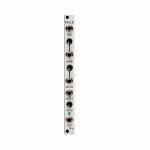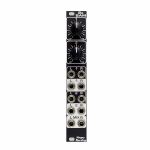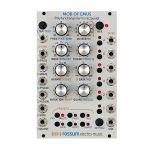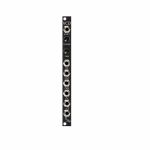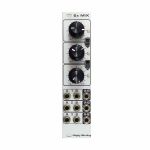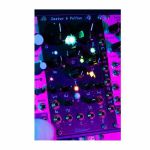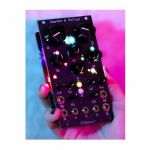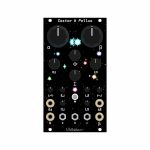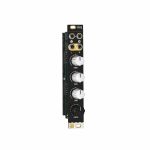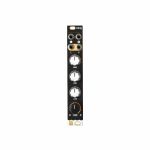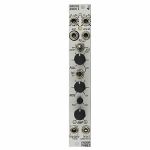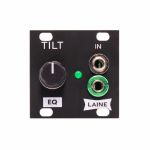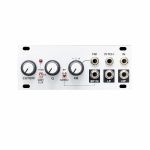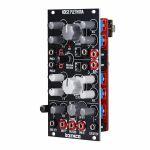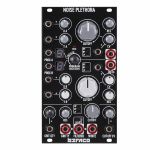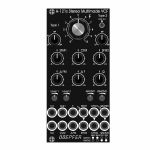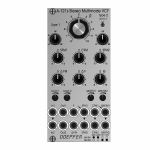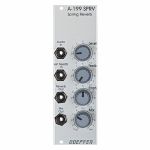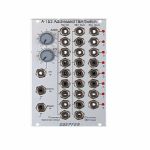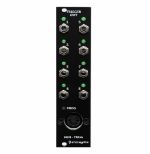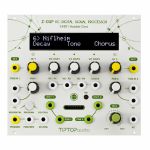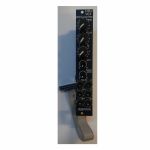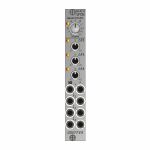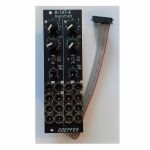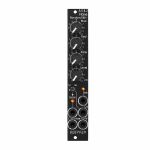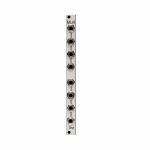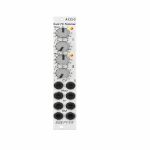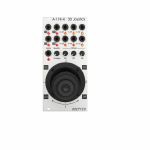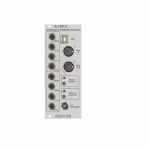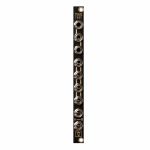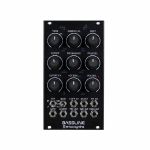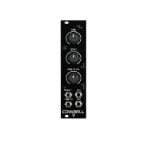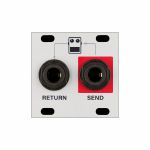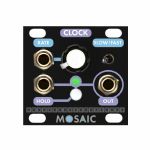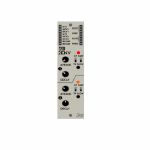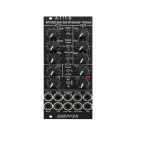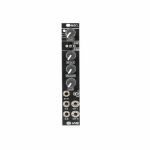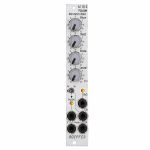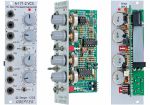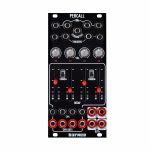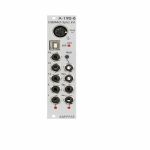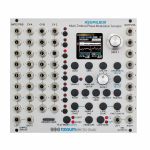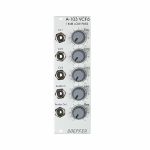100% Secure Shopping
Studio equipment
Our full range of studio equipment from all the leading equipment and software brands. Guaranteed fast delivery and low prices.
100% Secure Shopping
DJ equipment
Our full range of DJ equipment from all the leading equipment and software brands. Guaranteed fast delivery and low prices. Visit Juno DJ
Filter
Coming Soon
Equipment
Format
Release Date
906
Not Forthcoming
79
Forthcoming
5
Last Week
9
Last 2 Weeks
19
Last Month
47
Last 2 Months
158
Last 6 Months
263
Last Year
Brand
Featured
Price
Tags
ADDAC System ADDAC611 Gotharman's VC Tube Filter Module (black) (distortion/filter/mixer/tube synth module)
Cat: 776355 Rel: 08 Sep 20
Tube filter module
Notes: This module was developed upon the Tubaz Filter which was released in 2014 by Gotharman but is currently no longer in production. We loved the original module so much that we officially licensed it's circuit and expanded it to feature several new functionalities.
Here's a paragraph from Gotharman regarding the original design:
"I designed it with the purpose of adding crunch, edge and distortion to my eurorack system. It is not an ideal bandpass filter, that cuts off all frequencies above and below the center frequency.
Because of its high drive, there are, in most cases, some bleedthrough of the harmonics, that should have been cut off. You might consider calling it a "Band Add" filter. The main purpose of it, was to add edge, not to be a perfect bandpass filter."
While everything he mentions is still true we believe he was being modest, It's a dirty, gritty, growling and whining monster which promises you some of the most peculiar filter sounds you'll ever hear.
However do not classify it as a "weird" distortion unit just yet because besides this hairy character it can be easily tamed (using lower volume levels) and then, with some care and intention from the user, it will transforrm itself showing it's feline purrrrr and cuddle sweet and caring, or like any good mut, showing up at night all happy, wet and dirty from a full dog's day and will lay down at your feet while wiggling it's tail howling as yawning just happy to be back home.
As such, standard volume principles do not quite apply to these units, the Audio Levels will go up to x2 amplification, Drive will go up to x11 and master outs go up to x2. The combination of these will cover all diferent qualities it can present. Overall sound can be distorted pre-Tube (raising input levels), in Tube (raising drive) or post-Tube (raising Out levels).
Higher Inputs and Drive will always be gritty, lower Inputs and Drive volumes together with higher Output levels will make the overall behaviour more mellow and closer to what a typical filter would behave like.
No standard expectations should be considered when acquiring these units, all of the tubes were built in the 70's and were bought from various sources, we always kept the premise that no tube was a bad tube (unless not really workinng) so due to each specific characteristics no module will sound exactly the same, making each unit particularly unique. This uniqueness will be particularly evident on their resonance/self-oscilating timbre as well as in their own microphonic qualities.
Regarding power and current draw, the module is designed using a low power tube, so it won't starve your eurorack power supply.
Tech Specs:
12HP
3.5cm deep
90mA +12V
60mA -12V
… Read moreHere's a paragraph from Gotharman regarding the original design:
"I designed it with the purpose of adding crunch, edge and distortion to my eurorack system. It is not an ideal bandpass filter, that cuts off all frequencies above and below the center frequency.
Because of its high drive, there are, in most cases, some bleedthrough of the harmonics, that should have been cut off. You might consider calling it a "Band Add" filter. The main purpose of it, was to add edge, not to be a perfect bandpass filter."
While everything he mentions is still true we believe he was being modest, It's a dirty, gritty, growling and whining monster which promises you some of the most peculiar filter sounds you'll ever hear.
However do not classify it as a "weird" distortion unit just yet because besides this hairy character it can be easily tamed (using lower volume levels) and then, with some care and intention from the user, it will transforrm itself showing it's feline purrrrr and cuddle sweet and caring, or like any good mut, showing up at night all happy, wet and dirty from a full dog's day and will lay down at your feet while wiggling it's tail howling as yawning just happy to be back home.
As such, standard volume principles do not quite apply to these units, the Audio Levels will go up to x2 amplification, Drive will go up to x11 and master outs go up to x2. The combination of these will cover all diferent qualities it can present. Overall sound can be distorted pre-Tube (raising input levels), in Tube (raising drive) or post-Tube (raising Out levels).
Higher Inputs and Drive will always be gritty, lower Inputs and Drive volumes together with higher Output levels will make the overall behaviour more mellow and closer to what a typical filter would behave like.
No standard expectations should be considered when acquiring these units, all of the tubes were built in the 70's and were bought from various sources, we always kept the premise that no tube was a bad tube (unless not really workinng) so due to each specific characteristics no module will sound exactly the same, making each unit particularly unique. This uniqueness will be particularly evident on their resonance/self-oscilating timbre as well as in their own microphonic qualities.
Regarding power and current draw, the module is designed using a low power tube, so it won't starve your eurorack power supply.
Tech Specs:
12HP
3.5cm deep
90mA +12V
60mA -12V
1 in stock $332.66
2hp Pluck Physical Modelling Synth Voice Module (silver) (digital/oscillator/synth voice synth module)
Cat: 684048 Rel: 28 Mar 18
Karplus-Strong based physical modelling synth module - 2HP
Notes: Pluck is a physical modelling synth voice. It uses the Karplus-Strong algorithm to create plucked string sounds. The dampening control sets the size of the string and allows for dramatic timbral shifts.
The decay control changes note length from percussive transients to infinite harp sounds. In addition, four voice polyphony provides complex layered tones; all from a single sound source.
Strum a new chord with Pluck.
… Read moreThe decay control changes note length from percussive transients to infinite harp sounds. In addition, four voice polyphony provides complex layered tones; all from a single sound source.
Strum a new chord with Pluck.
2 in stock $115.12
Click for better price!
or call +44 20 7424 1960
quote 684048
quote 684048
Happy Nerding 2x SAM Dual Stereo Attenuator-Mixer Module (black) (attenuator/mixer/dual/stereo module)
Cat: 777908 Rel: 22 Jul 20
Dual stereo attenuator-mixer module - 4HP
Notes: 2xSAM is 4 HP Dual Stereo Attenuator-Mixer
Several 2xSAMs can be chained together or with other HN stereo modules via sockets on the back side.
2xSAM's total mix stereo output can be internally sent to the Isolator, PanMix Jr, 3xStereo Mixer, or can be received from OUT, PanMix, PanMix Jr, 3xStereo Mixer, or another 2xSAM.
If jumpers are not installed (placed on one pin only by default) the max gain is 1x. When the jumper is properly placed on both pins - the gain is 5x. There are four inputs thus four jumpers. Each jumper is relevant to its channel.
27 mA +12V
27 mA - 12V
35 mm Depth
4 HP wide
… Read moreSeveral 2xSAMs can be chained together or with other HN stereo modules via sockets on the back side.
2xSAM's total mix stereo output can be internally sent to the Isolator, PanMix Jr, 3xStereo Mixer, or can be received from OUT, PanMix, PanMix Jr, 3xStereo Mixer, or another 2xSAM.
If jumpers are not installed (placed on one pin only by default) the max gain is 1x. When the jumper is properly placed on both pins - the gain is 5x. There are four inputs thus four jumpers. Each jumper is relevant to its channel.
27 mA +12V
27 mA - 12V
35 mm Depth
4 HP wide
3 in stock $79.25
Click for better price!
or call +44 20 7424 1960
quote 777908
quote 777908
Rossum Electro-Music Mob Of Emus Polyfunctional Harmonic Sextet Module (envelope generator/LFO/oscillator/quantiser/sample & hold/CV modulation/digital/random synth module)
Cat: 797062 Rel: 25 Nov 20
Polyfunctional harmonic sextet module
Notes: *** Free software update available as a free download, along with updated documentation, at the Mob of Emus product page on the Rossum Electro-Music website***
A lot to unpack here. Six-channel multipurpose oscillator/noise source/modulation generator with quantisation, trigger generators and even more. Seriously powerful all-round digital goodness.
Supplier's Notes:
Mob of Emus is a powerful music and sound design tool that packs an enormous amount of creative power into an amazingly compact 16HP module.
Mob of Emus gives you six channels of oscillators, noise sources, cyclical and 1-shot modulators (including LFOs, envelopes, and various other shapes), sample and hold waveshapes, slow random modulators, triggers, rhythm patterns, and quantization (of both internal and external signals) in pretty much any combination (well, any combination of six channels, anyway).
In addition to being able to independently program the function of each individual channel, Mob of Emus' Hex Mode provides a macro control layer that allows you to control all of its channels simultaneously (while maintaining the relationships of each channel's independent programming).
What's more, Mob of Emus' "harmonic" control structure makes it extremely easy to combine its oscillators into rich additive timbres, to combine its LFOs into stacked harmonic low frequency modulation waves, and to create modulation sources and triggers with intricate polyrhythmic patterns.
With an external trigger input, six CV inputs that can operate in six different control modes, six independent outputs, and an assignable mix output, Mob of Emus can operate as the heart of an almost unlimited variety of patches. And its 8 real-time controls will give you immediate hands-on access to a channel's (or all six channels') key parameters, inviting (and rewarding) exploration and improvisation.
Mob of Emus features include:
Six channels that can function independently or can be further controlled by a Hex Mode macro layer that lets you control all six simultaneously. Channels can be:
Wide-range digital oscillators
Noise sources
Cyclical and 1-shot modulators (including LFOs, envelopes, and various other shapes)
Sample and hold waveshapes
Slow random modulators
Triggers
Rhythm patterns
Quantizers (of both internal and external(!) signals)
Six CV inputs that can function in six different control modes
Eight real-time controls for immediate access to key channel parameters
Six individual channel outputs and an assignable mix output
The ability to store and recall 12 user presets
And much more.
Mob of Emus is 16HP wide and 25mm deep.
Power requirements (max): 130mA +12V, 25mA -12V. Reverse polarity protected.
As of March 2021, there has been a been a small bug fix to the recent software update for Mob of Emus.
The update fixes a bug where holding the Channel Selector Buttons for a short time to select a single channel and deselect any others was not working correctly.
The update fixes a bug where some Hex Mode parameters were not ignored when Hex Mode was set to off.
The update introduces a feature allowing users to double-click and hold the Hex button to reset all Hex Mode parameters and set Hex Mode to on.
Rossum Electro-Music made a change to the behavior of the LEDS when using the utility 'Display Software Revision'
… Read moreA lot to unpack here. Six-channel multipurpose oscillator/noise source/modulation generator with quantisation, trigger generators and even more. Seriously powerful all-round digital goodness.
Supplier's Notes:
Mob of Emus is a powerful music and sound design tool that packs an enormous amount of creative power into an amazingly compact 16HP module.
Mob of Emus gives you six channels of oscillators, noise sources, cyclical and 1-shot modulators (including LFOs, envelopes, and various other shapes), sample and hold waveshapes, slow random modulators, triggers, rhythm patterns, and quantization (of both internal and external signals) in pretty much any combination (well, any combination of six channels, anyway).
In addition to being able to independently program the function of each individual channel, Mob of Emus' Hex Mode provides a macro control layer that allows you to control all of its channels simultaneously (while maintaining the relationships of each channel's independent programming).
What's more, Mob of Emus' "harmonic" control structure makes it extremely easy to combine its oscillators into rich additive timbres, to combine its LFOs into stacked harmonic low frequency modulation waves, and to create modulation sources and triggers with intricate polyrhythmic patterns.
With an external trigger input, six CV inputs that can operate in six different control modes, six independent outputs, and an assignable mix output, Mob of Emus can operate as the heart of an almost unlimited variety of patches. And its 8 real-time controls will give you immediate hands-on access to a channel's (or all six channels') key parameters, inviting (and rewarding) exploration and improvisation.
Mob of Emus features include:
Six channels that can function independently or can be further controlled by a Hex Mode macro layer that lets you control all six simultaneously. Channels can be:
Wide-range digital oscillators
Noise sources
Cyclical and 1-shot modulators (including LFOs, envelopes, and various other shapes)
Sample and hold waveshapes
Slow random modulators
Triggers
Rhythm patterns
Quantizers (of both internal and external(!) signals)
Six CV inputs that can function in six different control modes
Eight real-time controls for immediate access to key channel parameters
Six individual channel outputs and an assignable mix output
The ability to store and recall 12 user presets
And much more.
Mob of Emus is 16HP wide and 25mm deep.
Power requirements (max): 130mA +12V, 25mA -12V. Reverse polarity protected.
As of March 2021, there has been a been a small bug fix to the recent software update for Mob of Emus.
The update fixes a bug where holding the Channel Selector Buttons for a short time to select a single channel and deselect any others was not working correctly.
The update fixes a bug where some Hex Mode parameters were not ignored when Hex Mode was set to off.
The update introduces a feature allowing users to double-click and hold the Hex button to reset all Hex Mode parameters and set Hex Mode to on.
Rossum Electro-Music made a change to the behavior of the LEDS when using the utility 'Display Software Revision'
1 in stock $427.65
2hp Sine Harmonically Pure VCO Module (black) (oscillator synth module)
Cat: 727389 Rel: 02 Oct 19
Digital oscillator module with sub output & wavefolding - black
Notes: Sine is a harmonically pure VCO with two distinct outputs.
The primary output contains a perfect sine wave with a wide frequency range and pristine volt per octave tracking. The Sub output features two sine tones that can be blended together to achieve a mix of one octave below, or a fifth above the primary output's frequency.
In addition, both outputs have an internal wavefolder that adds harmonic content to the signal allowing for spectrally complex tones within a single module. Keep your tones pure (or not!) with Sine.
… Read moreThe primary output contains a perfect sine wave with a wide frequency range and pristine volt per octave tracking. The Sub output features two sine tones that can be blended together to achieve a mix of one octave below, or a fifth above the primary output's frequency.
In addition, both outputs have an internal wavefolder that adds harmonic content to the signal allowing for spectrally complex tones within a single module. Keep your tones pure (or not!) with Sine.
1 in stock $143.90
Click for better price!
or call +44 20 7424 1960
quote 727389
quote 727389
Happy Nerding 6x MIX 6-Channel Audio Mixer Module (silver) (synth module)
Cat: 777890 Rel: 22 Jul 20
Audio mixer module
Notes: 6xMIX is a six channel audio (AC coupled ) mixer, channels arranged in three groups with separate outputs having led indicators. Each group can be switched to mix with the subsequent group, allowing for 2-2-2, 4-2, 6 mix configurations. The module can also be used to mix two stereo channels plus separate group of two mono channels. Perfect audio performance with the lowest noise and distortion amounts.
The inner knobs control the A inputs, while the outer knobs control the B inputs.
50 mA +12V
50 mA -12V
35 mm Depth
6 HP wide
… Read moreThe inner knobs control the A inputs, while the outer knobs control the B inputs.
50 mA +12V
50 mA -12V
35 mm Depth
6 HP wide
1 in stock $91.77
Click for better price!
or call +44 20 7424 1960
quote 777890
quote 777890
Winterbloom Castor & Pollux II Dual Juno-Inspired Oscillator Module (digital/dual/stereo/oscillator module)
Cat: 939094 Rel: 05 Jan 24
Dual Juno-inspired oscillator module - 14HP
Notes: A Juno-inspired oscillator module? We're flattered, but credit has to go to Roland for this one. Based on the Juno-106's digitally-controlled analogue oscillators, the Castor & Pollux modernises the 80s design with a built-in LFO and hard sync.
Supplier's Notes:
Twins that dance in and out of phase, never completely together but never fully apart, bound to each other in the infinite universe.
Castor & Pollux is a dual oscillator that echoes back to the legendary Roland Juno but shines with its own unique, massive voice. It contains two digitally-controlled analogue oscillators implemented using a faithfully modernized version of the original Juno 106 design. It builds on the classic '80s sounds of its inspiration by using the second oscillator and internal LFO to layer in thick detuned sounds and harmonically complex hard synced waveforms.
Castor & Pollux II brings a redesigned interface and moves individual waveform outputs to an included expansion. Both versions have the same features and use the same firmware.
14 HP
+12 V @ 100 mA, -12 V @ 35 mA
25 mm deep
2 separate oscillators
7 octave range
9 total outputs with waveform outputs and onboard mixers
Pitch CV input jacks (0 V to 6 V) and pitch knobs (-1 to +1 octave, configurable)
Pulse width CV input jacks and knobs
Hard sync
Hardware chorusing
Internal low-frequency oscillator (LFO)
… Read moreSupplier's Notes:
Twins that dance in and out of phase, never completely together but never fully apart, bound to each other in the infinite universe.
Castor & Pollux is a dual oscillator that echoes back to the legendary Roland Juno but shines with its own unique, massive voice. It contains two digitally-controlled analogue oscillators implemented using a faithfully modernized version of the original Juno 106 design. It builds on the classic '80s sounds of its inspiration by using the second oscillator and internal LFO to layer in thick detuned sounds and harmonically complex hard synced waveforms.
Castor & Pollux II brings a redesigned interface and moves individual waveform outputs to an included expansion. Both versions have the same features and use the same firmware.
14 HP
+12 V @ 100 mA, -12 V @ 35 mA
25 mm deep
2 separate oscillators
7 octave range
9 total outputs with waveform outputs and onboard mixers
Pitch CV input jacks (0 V to 6 V) and pitch knobs (-1 to +1 octave, configurable)
Pulse width CV input jacks and knobs
Hard sync
Hardware chorusing
Internal low-frequency oscillator (LFO)
3 in stock $301.37
Click for better price!
or call +44 20 7424 1960
quote 939094
quote 939094
NANO Modules CEQ Analogue 3-Band Equalizer & Compressor Module (equalizer/dynamics synth module)
Cat: 935474 Rel: 13 Apr 23
An analogue 3-band equalizer and compressor module in 4HP.
Notes: CEQ is an analogue 3-band Equalizer and Compressor module in 4HP. Enhance your synth voices, get some punch and have fun playing with the DJ-style EQ.
CEQ is perfect for your final live mix or you can even use several on individual synth voices.
Great versatility.
CEQ Compressor can be used to subtly tune the dynamics of your voice, saturate or distort it heavily and everything in between. Want to sound a little fatter? This one is for you.
Synth tracks will love it.
Thanks to a switch on the back of the module, you can adjust the compression speed between FAST and SLOW depending on your needs.
CEQ is an analogue module.
NO digital noise.
BIG headroom.
Specifications:
EQ Cuttoff Frequency
High: 2567Hz
Mid: 256Hz to 2567Hz
Low: 256Hz
Filter type Sallen Key configuration.
Filter Q 0.5
Dimensions 4HP - 20×128,5mm
… Read moreCEQ is perfect for your final live mix or you can even use several on individual synth voices.
Great versatility.
CEQ Compressor can be used to subtly tune the dynamics of your voice, saturate or distort it heavily and everything in between. Want to sound a little fatter? This one is for you.
Synth tracks will love it.
Thanks to a switch on the back of the module, you can adjust the compression speed between FAST and SLOW depending on your needs.
CEQ is an analogue module.
NO digital noise.
BIG headroom.
Specifications:
EQ Cuttoff Frequency
High: 2567Hz
Mid: 256Hz to 2567Hz
Low: 256Hz
Filter type Sallen Key configuration.
Filter Q 0.5
Dimensions 4HP - 20×128,5mm
1 in stock $102.19
2hp VCA Dual Linear VCA Module (silver) (dual/stereo/VCA/attenuator synth module)
Cat: 638773 Rel: 21 Feb 17
Dual linear VCA module with CV input attenuator & DC-coupled inputs
Notes: The 2hp VCA is a dual, linear VCA. It uses the renowned 2164 SSM architecture, giving it extremely low distortion and high quality audio outputs. With a CV input attenuator, and DC-coupled inputs this is your new go-to module for voltage controlled amplification of audio or CV.
… Read more 1 in stock $98.02
Click for better price!
or call +44 20 7424 1960
quote 638773
quote 638773
Endorphin.es Airstreamer 4 Envelope Generator Module With Looping/ASR/AD Modes (silver) (attenuator/envelope generator/function generator/polarizer/sample & Hold/slew limiter/VCA synth module)
Cat: 880288 Rel: 02 Dec 22
Ultra slim envelope generator with looping, ASR and AD modes
Notes: Ultra slim envelope generator with looping, ASR and AD modes
CV control over fall (decay / release)
Continuously variable shape over both slopes without stretching the slope's duration in time.
Low aliasing CV generation, 224 kHz sample rate.
1 v/oct input, bipolar and unipolar outputs, end of cycle output.
Audio rate oscillation in cycle mode allows you to utilize it as an oscillator.
Polarizer knob with additional VCA input scales the envelope and inverts it when CV goes to negative voltages, allowing for compact sidechain envelope solution without the need for external mixers / inverts / offset generators.
Slew limiter, S&H, T&H processing for external CV sources
Power consumption:
60 mA +12V
15 mA -12V
0 mA 5V
Dimensions:
4 HP
26 mm deep with power ribbon cable connected
… Read moreCV control over fall (decay / release)
Continuously variable shape over both slopes without stretching the slope's duration in time.
Low aliasing CV generation, 224 kHz sample rate.
1 v/oct input, bipolar and unipolar outputs, end of cycle output.
Audio rate oscillation in cycle mode allows you to utilize it as an oscillator.
Polarizer knob with additional VCA input scales the envelope and inverts it when CV goes to negative voltages, allowing for compact sidechain envelope solution without the need for external mixers / inverts / offset generators.
Slew limiter, S&H, T&H processing for external CV sources
Power consumption:
60 mA +12V
15 mA -12V
0 mA 5V
Dimensions:
4 HP
26 mm deep with power ribbon cable connected
1 in stock $158.50
Click for better price!
or call +44 20 7424 1960
quote 880288
quote 880288
Laine Tilt 1U Wide Tone Adjustment Module With One Control (black) (equaliser/filter module)
Cat: 1007999 Rel: 26 Mar 24
Wide tone adjustment 1U module with one control - 8HP
Notes: Tilt is the first in Laine's series of core modules, which will take cues from the main product line and strip back the features so both the module width and cost can be shrunk dramatically.
Comprising an 'Ambler' style tilt EQ network similar to the 'Stilts' topology, Tilt allows simultaneous cut and boost of low and high frequencies using a single control.
Tilt control circuits are known for the transparency of their cut and boost curves, coupled with the inherent emphasis gained from cutting one end of the frequency spectrum whilst boosting at the opposite end.
It sounds pretty good on all audio source material but is especially suited to tracking drums, guitar and lead, or manipulating effects sends and returns.
With the control knob at 12o'clock the sound passed is neutral. Turning the control knob clockwise will boost high and cut low frequencies pivoting from a fixed mid-range point. Turning the control anti-clockwise below 12 o clock will in turn boost low frequencies and cut the highs.
In addition to the EQ there is a soft clipping network which will begin to saturate signals over 15 volts peak to peak.
Tilt uses the same high quality OPA op amps, Alpha pots and ENIG PCBs as found in our main product line.
Features
Compact EQ tilt control in 1U
Soft clipping network
High-quality components used throughout
Specifications
Intellijel 1U format
Width 8HP
Depth 28mm
Power requirements ~10mA +12V/~10mA -12V
Impedance Input 100k / Output 1k
… Read moreComprising an 'Ambler' style tilt EQ network similar to the 'Stilts' topology, Tilt allows simultaneous cut and boost of low and high frequencies using a single control.
Tilt control circuits are known for the transparency of their cut and boost curves, coupled with the inherent emphasis gained from cutting one end of the frequency spectrum whilst boosting at the opposite end.
It sounds pretty good on all audio source material but is especially suited to tracking drums, guitar and lead, or manipulating effects sends and returns.
With the control knob at 12o'clock the sound passed is neutral. Turning the control knob clockwise will boost high and cut low frequencies pivoting from a fixed mid-range point. Turning the control anti-clockwise below 12 o clock will in turn boost low frequencies and cut the highs.
In addition to the EQ there is a soft clipping network which will begin to saturate signals over 15 volts peak to peak.
Tilt uses the same high quality OPA op amps, Alpha pots and ENIG PCBs as found in our main product line.
Features
Compact EQ tilt control in 1U
Soft clipping network
High-quality components used throughout
Specifications
Intellijel 1U format
Width 8HP
Depth 28mm
Power requirements ~10mA +12V/~10mA -12V
Impedance Input 100k / Output 1k
1 in stock $50.84
Click for better price!
or call +44 20 7424 1960
quote 1007999
quote 1007999
After Later Audio Cloverleaf 1U Case Jack Interface Module For Intellijel Cases With Headphone Amp (interface synth module)
Cat: 900389 Rel: 21 Sep 22
An interface for the case 1/4" jacks in Intelljel cases
Notes: An interface for the case 1/4" jacks in Intelljel cases. The jacks are marked as if they are part of the case, so the jacks marked out, require an input.
The module sports both input and output for either a consumer line level (0.447Vpk) or a professional line level (1.095Vpk). These levels are controllable via jumper on the back of the module. It can also have a single input and output channel switched to pedal level. The case output is fed to the headphone amp that has a corresponding level control. The module otherwise does not have any level control and relies on using a VCA or other module to perform any level controls.
The module can essentially be run in one of three modes:
1) Stereo line level in and out
2) Stereo line level in and out via the left side and mono pedal in and out on the right side. In this mode the stereo line levels leverage TRS on the 1/4" jacks. You can use the included 3.5mm couplers to get TRS on the 3.5mm side.
3) Mono line level in and out via the left side and mono pedal in and out on the right side.
For Palette 64hp users only have two 1/4" jacks. You can choose if you want to use the case jacks as either inputs, outputs, or one input and one output.
… Read moreThe module sports both input and output for either a consumer line level (0.447Vpk) or a professional line level (1.095Vpk). These levels are controllable via jumper on the back of the module. It can also have a single input and output channel switched to pedal level. The case output is fed to the headphone amp that has a corresponding level control. The module otherwise does not have any level control and relies on using a VCA or other module to perform any level controls.
The module can essentially be run in one of three modes:
1) Stereo line level in and out
2) Stereo line level in and out via the left side and mono pedal in and out on the right side. In this mode the stereo line levels leverage TRS on the 1/4" jacks. You can use the included 3.5mm couplers to get TRS on the 3.5mm side.
3) Mono line level in and out via the left side and mono pedal in and out on the right side.
For Palette 64hp users only have two 1/4" jacks. You can choose if you want to use the case jacks as either inputs, outputs, or one input and one output.
1 in stock $96.97
Click for better price!
or call +44 20 7424 1960
quote 900389
quote 900389
Intellijel SVF 1U Multi-Mode State Variable Filter Module (filter/oscillator synth module)
Cat: 962204 Rel: 04 Aug 23
Multi-mode state variable filter module - 20HP.
Notes: SVF 1U
Multimode State Variable Filter
The perfect 1U, multimode, voltage-controlled filter for sweet-sounding subtractive synthesis duties or to form the basis of more complex patches. Punchy, clean, and precise. Explore new sounds through the dual modulation inputs and dedicated low pass, high pass and band pass/notch outputs. This filter responds beautifully to audio rate FM and you can self-patch to get even more interesting filter responses. Adjust the Q for a sharp howl or use it as a sine VCO.
Features:
Dedicated 2-pole Low pass filter (LP) and 2-pole High pass filter (HP) outputs.
Switchable Bandpass filter (BP) and Notch filter (N) output.
Optional +6dB input boost and asymmetric clipping circuit.
PITCH input tracks 1V/Oct accurately over 4+ octaves.
FM CV input with attenuverter.
Capable of generating very low distortion sine waves from 2Hz to 20kHz when driven to self oscillation (Max Q).
Size: 20HP
Depth: 35mm
Power: 27mA @ +12V 30mA @ -12V
… Read moreMultimode State Variable Filter
The perfect 1U, multimode, voltage-controlled filter for sweet-sounding subtractive synthesis duties or to form the basis of more complex patches. Punchy, clean, and precise. Explore new sounds through the dual modulation inputs and dedicated low pass, high pass and band pass/notch outputs. This filter responds beautifully to audio rate FM and you can self-patch to get even more interesting filter responses. Adjust the Q for a sharp howl or use it as a sine VCO.
Features:
Dedicated 2-pole Low pass filter (LP) and 2-pole High pass filter (HP) outputs.
Switchable Bandpass filter (BP) and Notch filter (N) output.
Optional +6dB input boost and asymmetric clipping circuit.
PITCH input tracks 1V/Oct accurately over 4+ octaves.
FM CV input with attenuverter.
Capable of generating very low distortion sine waves from 2Hz to 20kHz when driven to self oscillation (Max Q).
Size: 20HP
Depth: 35mm
Power: 27mA @ +12V 30mA @ -12V
2 in stock $119.71
Befaco Noise Plethora 4-Voice Algorithmic Noise Generator Module (filter/noise synth module)
Cat: 846576 Rel: 06 Dec 21
Triple noise generator with multi mode filters.
Notes: A typically comprehensive approach to noise sources from Befaco, featuring five different circuits plus two analogue multimode filters and plenty of CV controls for sculpting the output.
Supplier's Notes:
Noise plethora has three different noise generators:
The first two are identical and are composed of digital algorithms followed by a 12dB analog multimode filter.
Each program has two variables (Named X and Y) addressed by two manual controls and two associated control voltage INs.
Ships with an extensive (and expanding) algorithms library: textures, wave clusters, harsh noises, and glitches.
Generator C has three simultaneous outputs:
White. Flat Response Classic white noise.
Gritty. Granulous texture noise, with voltage-controlled grit quantity.
Filtered. Is the White or Gritty noise followed by a 24dB multimode VCF.
A total of 5 different noise sources in one module!
Dimensions:
14 HP
25 mm deep
Current Draw
110 mA +12V
67 mA -12V
0 mA 5V
… Read moreSupplier's Notes:
Noise plethora has three different noise generators:
The first two are identical and are composed of digital algorithms followed by a 12dB analog multimode filter.
Each program has two variables (Named X and Y) addressed by two manual controls and two associated control voltage INs.
Ships with an extensive (and expanding) algorithms library: textures, wave clusters, harsh noises, and glitches.
Generator C has three simultaneous outputs:
White. Flat Response Classic white noise.
Gritty. Granulous texture noise, with voltage-controlled grit quantity.
Filtered. Is the White or Gritty noise followed by a 24dB multimode VCF.
A total of 5 different noise sources in one module!
Dimensions:
14 HP
25 mm deep
Current Draw
110 mA +12V
67 mA -12V
0 mA 5V
1 in stock $310.76
Click for better price!
or call +44 20 7424 1960
quote 846576
quote 846576
Doepfer A-121sV Stereo Multimode Filter Vintage Edition Module (black) (dual/stereo/filter synth module)
Cat: 880251 Rel: 18 Aug 22
Module A-121s is a dual multimode filter which can be used for stereo applications as well as for parallel or serial organized dual mono filters.
Notes: Module A-121s is a dual multimode filter which can be used for stereo applications as well as for parallel or serial organized dual mono filters. The core is a 12dB multimode filter identical to the modules A-121-2 and A-121-3. The selection of the filter type is continuously from lowpass via notch and highpass to bandpass. We attached great importance to the usability of the manual controls and CV inputs for both stereo and dual mono applications. For the filter parameters frequency (F), resonance (Q) and type (T) common controls and CV inputs as well as single controls and CV inputs are available. For the filter frequency in addition a manual control and CV input for the filter spread (frequency difference or delta F) is available.
Controls:
F: master frequency control for both filters (large knob)
Type 1 / Type 2: filter type panning/morphing L-N-H-B
Link to 1: Toggle switch so that Type 1 also controls type of filter 2 (i.e. simultaneous filter type control for both filters)
SFM1 / SFM2: Single Frequency Modulation controls (polarizers), connected to the corresponding sockets SFM1/SFM2 (socket SFM1 is normalled to a fixed positive voltage, SFM2 is normalled to SFM1, that way the controls SFM1/SFM2 work as frequency controls for each filter provided that no modulation signals are patched to the SFM1/SFM2 sockets)
CFM: common frequency control, controls two VC-polarizers which process the signals connected to the two sockets CFM1/CFM2, CFM2 is normalled to CFM1, that way also the same modulation signal (e.g. an envelope generator) can be used for both filters and the level controlled simultaneously by the CFM control
Delta F: controls the difference between the frequencies of the two filters manually (frequency "spread"), at centre position the frequencies are the same
Delta FM: controls the level of the Delta FM signal (socket), which allows to control the spread between the frequencies also by an external control voltage (e.g. by an LFO or ADSR)
Q: controls the resonance of both filters simultaneously
Level 1 / Level 2: attenuators for the two audio inputs
QM/TM1, QM/TM2: attenuators for the modulation inputs QM/TM1 and QM/TM2
Sockets:
In1 / In2: audio inputs (In2 is normalled to In1)
Out1 / Out2: audio outputs
F: common frequency control input for both filters (~ 1V/oct)
Delta FM: Control voltage for frequency spread, processed by the polarizer Delta FM
SFM1 / SFM2: single frequency modulation inputs, processed by the polarizers SFM1 and SFM2, SFM1 is normalled to a fixed positive voltage, SFM2 is normalled to SFM1#
CFM1 / CFM2: common frequency modulation inputs, processed by the two voltage controlled polarizers controlled by CFM knob, CFM2 is normalled to CFM1
QM/TM1, QM/TM2: the addressing of these sockets/attenuators is defined by internal jumpers. QM means Q modulation (i.e. resonance modulation), TM means filter type modulation (QM1 = resonance modulation filter 1, QM2 = resonance modulation filter 2, TM1 = filter type modulation filter 1, TM2 = filter type modulation filter 2), socket QM/TM1 is normalled to a fixed positive voltage, QM/TM2 is normalled to QM/TM1
A 45 degrees triangle next to a socket means that the switching contact of the socket is normalled to a fixed positive voltage (SFM1, QM/TM1).
A vertical triangle indicates the normalling of two sockets (In1>In2, SFM1>SFM2, CFM1>CFM2, QM/TM1>QM/TM2).
If the filters do not behave as expected please pay attention to these peculiarities:
For the controls SFM1, SFM2, CFM, Delta F and Delta FM the centre position is the neutral position as these are polarizers. If the filter behaves unexpected these controls should be set to centre positions for the time being.
For the controls F, Q, Level 1, Level 2, QM/TM1 und QM/TM2 the fully CCW position is the neutral position as these are standard attenuators. If the filter behaves unexpected at least the controls QM/TM1 and QM/TM2 should be set to fully CCW. Via the normalling of the sockets QM/TM1 and QM/TM2 and the associated controls the filter parameters adjusted by the major controls (e.g. Type 1, Type 2 or Q) may be overwritten.
By means of small circles at the bottom right side of the front panel the user can mark the function of the QM/TM inputs. These assignments are possible:
QM/TM1 controls QM1, QM/TM2 controls QM2, the filter types are not controlled by external CVs
QM/TM1 controls TM1, QM/TM2 controls TM2, the resonances are not controlled by external CVs
QM/TM1 controls QM1 and QM2 simultaneously, QM/TM2 controls TM1 and TM2 simultaneously
… Read moreControls:
F: master frequency control for both filters (large knob)
Type 1 / Type 2: filter type panning/morphing L-N-H-B
Link to 1: Toggle switch so that Type 1 also controls type of filter 2 (i.e. simultaneous filter type control for both filters)
SFM1 / SFM2: Single Frequency Modulation controls (polarizers), connected to the corresponding sockets SFM1/SFM2 (socket SFM1 is normalled to a fixed positive voltage, SFM2 is normalled to SFM1, that way the controls SFM1/SFM2 work as frequency controls for each filter provided that no modulation signals are patched to the SFM1/SFM2 sockets)
CFM: common frequency control, controls two VC-polarizers which process the signals connected to the two sockets CFM1/CFM2, CFM2 is normalled to CFM1, that way also the same modulation signal (e.g. an envelope generator) can be used for both filters and the level controlled simultaneously by the CFM control
Delta F: controls the difference between the frequencies of the two filters manually (frequency "spread"), at centre position the frequencies are the same
Delta FM: controls the level of the Delta FM signal (socket), which allows to control the spread between the frequencies also by an external control voltage (e.g. by an LFO or ADSR)
Q: controls the resonance of both filters simultaneously
Level 1 / Level 2: attenuators for the two audio inputs
QM/TM1, QM/TM2: attenuators for the modulation inputs QM/TM1 and QM/TM2
Sockets:
In1 / In2: audio inputs (In2 is normalled to In1)
Out1 / Out2: audio outputs
F: common frequency control input for both filters (~ 1V/oct)
Delta FM: Control voltage for frequency spread, processed by the polarizer Delta FM
SFM1 / SFM2: single frequency modulation inputs, processed by the polarizers SFM1 and SFM2, SFM1 is normalled to a fixed positive voltage, SFM2 is normalled to SFM1#
CFM1 / CFM2: common frequency modulation inputs, processed by the two voltage controlled polarizers controlled by CFM knob, CFM2 is normalled to CFM1
QM/TM1, QM/TM2: the addressing of these sockets/attenuators is defined by internal jumpers. QM means Q modulation (i.e. resonance modulation), TM means filter type modulation (QM1 = resonance modulation filter 1, QM2 = resonance modulation filter 2, TM1 = filter type modulation filter 1, TM2 = filter type modulation filter 2), socket QM/TM1 is normalled to a fixed positive voltage, QM/TM2 is normalled to QM/TM1
A 45 degrees triangle next to a socket means that the switching contact of the socket is normalled to a fixed positive voltage (SFM1, QM/TM1).
A vertical triangle indicates the normalling of two sockets (In1>In2, SFM1>SFM2, CFM1>CFM2, QM/TM1>QM/TM2).
If the filters do not behave as expected please pay attention to these peculiarities:
For the controls SFM1, SFM2, CFM, Delta F and Delta FM the centre position is the neutral position as these are polarizers. If the filter behaves unexpected these controls should be set to centre positions for the time being.
For the controls F, Q, Level 1, Level 2, QM/TM1 und QM/TM2 the fully CCW position is the neutral position as these are standard attenuators. If the filter behaves unexpected at least the controls QM/TM1 and QM/TM2 should be set to fully CCW. Via the normalling of the sockets QM/TM1 and QM/TM2 and the associated controls the filter parameters adjusted by the major controls (e.g. Type 1, Type 2 or Q) may be overwritten.
By means of small circles at the bottom right side of the front panel the user can mark the function of the QM/TM inputs. These assignments are possible:
QM/TM1 controls QM1, QM/TM2 controls QM2, the filter types are not controlled by external CVs
QM/TM1 controls TM1, QM/TM2 controls TM2, the resonances are not controlled by external CVs
QM/TM1 controls QM1 and QM2 simultaneously, QM/TM2 controls TM1 and TM2 simultaneously
1 in stock $242.97
Doepfer A-121s Stereo Multimode Filter Module (silver) (dual/stereo/filter synth module)
Cat: 880248 Rel: 19 Aug 22
Module A-121s is a dual multimode filter which can be used for stereo applications as well as for parallel or serial organized dual mono filters.
Notes: Module A-121s is a dual multimode filter which can be used for stereo applications as well as for parallel or serial organized dual mono filters. The core is a 12dB multimode filter identical to the modules A-121-2 and A-121-3. The selection of the filter type is continuously from lowpass via notch and highpass to bandpass. We attached great importance to the usability of the manual controls and CV inputs for both stereo and dual mono applications. For the filter parameters frequency (F), resonance (Q) and type (T) common controls and CV inputs as well as single controls and CV inputs are available. For the filter frequency in addition a manual control and CV input for the filter spread (frequency difference or delta F) is available.
Controls:
F: master frequency control for both filters (large knob)
Type 1 / Type 2: filter type panning/morphing L-N-H-B
Link to 1: Toggle switch so that Type 1 also controls type of filter 2 (i.e. simultaneous filter type control for both filters)
SFM1 / SFM2: Single Frequency Modulation controls (polarizers), connected to the corresponding sockets SFM1/SFM2 (socket SFM1 is normalled to a fixed positive voltage, SFM2 is normalled to SFM1, that way the controls SFM1/SFM2 work as frequency controls for each filter provided that no modulation signals are patched to the SFM1/SFM2 sockets)
CFM: common frequency control, controls two VC-polarizers which process the signals connected to the two sockets CFM1/CFM2, CFM2 is normalled to CFM1, that way also the same modulation signal (e.g. an envelope generator) can be used for both filters and the level controlled simultaneously by the CFM control
Delta F: controls the difference between the frequencies of the two filters manually (frequency "spread"), at centre position the frequencies are the same
Delta FM: controls the level of the Delta FM signal (socket), which allows to control the spread between the frequencies also by an external control voltage (e.g. by an LFO or ADSR)
Q: controls the resonance of both filters simultaneously
Level 1 / Level 2: attenuators for the two audio inputs
QM/TM1, QM/TM2: attenuators for the modulation inputs QM/TM1 and QM/TM2
Sockets:
In1 / In2: audio inputs (In2 is normalled to In1)
Out1 / Out2: audio outputs
F: common frequency control input for both filters (~ 1V/oct)
Delta FM: Control voltage for frequency spread, processed by the polarizer Delta FM
SFM1 / SFM2: single frequency modulation inputs, processed by the polarizers SFM1 and SFM2, SFM1 is normalled to a fixed positive voltage, SFM2 is normalled to SFM1#
CFM1 / CFM2: common frequency modulation inputs, processed by the two voltage controlled polarizers controlled by CFM knob, CFM2 is normalled to CFM1
QM/TM1, QM/TM2: the addressing of these sockets/attenuators is defined by internal jumpers. QM means Q modulation (i.e. resonance modulation), TM means filter type modulation (QM1 = resonance modulation filter 1, QM2 = resonance modulation filter 2, TM1 = filter type modulation filter 1, TM2 = filter type modulation filter 2), socket QM/TM1 is normalled to a fixed positive voltage, QM/TM2 is normalled to QM/TM1
A 45 degrees triangle next to a socket means that the switching contact of the socket is normalled to a fixed positive voltage (SFM1, QM/TM1).
A vertical triangle indicates the normalling of two sockets (In1>In2, SFM1>SFM2, CFM1>CFM2, QM/TM1>QM/TM2).
If the filters do not behave as expected please pay attention to these peculiarities:
For the controls SFM1, SFM2, CFM, Delta F and Delta FM the centre position is the neutral position as these are polarizers. If the filter behaves unexpected these controls should be set to centre positions for the time being.
For the controls F, Q, Level 1, Level 2, QM/TM1 und QM/TM2 the fully CCW position is the neutral position as these are standard attenuators. If the filter behaves unexpected at least the controls QM/TM1 and QM/TM2 should be set to fully CCW. Via the normalling of the sockets QM/TM1 and QM/TM2 and the associated controls the filter parameters adjusted by the major controls (e.g. Type 1, Type 2 or Q) may be overwritten.
By means of small circles at the bottom right side of the front panel the user can mark the function of the QM/TM inputs. These assignments are possible:
QM/TM1 controls QM1, QM/TM2 controls QM2, the filter types are not controlled by external CVs
QM/TM1 controls TM1, QM/TM2 controls TM2, the resonances are not controlled by external CVs
QM/TM1 controls QM1 and QM2 simultaneously, QM/TM2 controls TM1 and TM2 simultaneously
Depth: 45mm
HP : 12
… Read moreControls:
F: master frequency control for both filters (large knob)
Type 1 / Type 2: filter type panning/morphing L-N-H-B
Link to 1: Toggle switch so that Type 1 also controls type of filter 2 (i.e. simultaneous filter type control for both filters)
SFM1 / SFM2: Single Frequency Modulation controls (polarizers), connected to the corresponding sockets SFM1/SFM2 (socket SFM1 is normalled to a fixed positive voltage, SFM2 is normalled to SFM1, that way the controls SFM1/SFM2 work as frequency controls for each filter provided that no modulation signals are patched to the SFM1/SFM2 sockets)
CFM: common frequency control, controls two VC-polarizers which process the signals connected to the two sockets CFM1/CFM2, CFM2 is normalled to CFM1, that way also the same modulation signal (e.g. an envelope generator) can be used for both filters and the level controlled simultaneously by the CFM control
Delta F: controls the difference between the frequencies of the two filters manually (frequency "spread"), at centre position the frequencies are the same
Delta FM: controls the level of the Delta FM signal (socket), which allows to control the spread between the frequencies also by an external control voltage (e.g. by an LFO or ADSR)
Q: controls the resonance of both filters simultaneously
Level 1 / Level 2: attenuators for the two audio inputs
QM/TM1, QM/TM2: attenuators for the modulation inputs QM/TM1 and QM/TM2
Sockets:
In1 / In2: audio inputs (In2 is normalled to In1)
Out1 / Out2: audio outputs
F: common frequency control input for both filters (~ 1V/oct)
Delta FM: Control voltage for frequency spread, processed by the polarizer Delta FM
SFM1 / SFM2: single frequency modulation inputs, processed by the polarizers SFM1 and SFM2, SFM1 is normalled to a fixed positive voltage, SFM2 is normalled to SFM1#
CFM1 / CFM2: common frequency modulation inputs, processed by the two voltage controlled polarizers controlled by CFM knob, CFM2 is normalled to CFM1
QM/TM1, QM/TM2: the addressing of these sockets/attenuators is defined by internal jumpers. QM means Q modulation (i.e. resonance modulation), TM means filter type modulation (QM1 = resonance modulation filter 1, QM2 = resonance modulation filter 2, TM1 = filter type modulation filter 1, TM2 = filter type modulation filter 2), socket QM/TM1 is normalled to a fixed positive voltage, QM/TM2 is normalled to QM/TM1
A 45 degrees triangle next to a socket means that the switching contact of the socket is normalled to a fixed positive voltage (SFM1, QM/TM1).
A vertical triangle indicates the normalling of two sockets (In1>In2, SFM1>SFM2, CFM1>CFM2, QM/TM1>QM/TM2).
If the filters do not behave as expected please pay attention to these peculiarities:
For the controls SFM1, SFM2, CFM, Delta F and Delta FM the centre position is the neutral position as these are polarizers. If the filter behaves unexpected these controls should be set to centre positions for the time being.
For the controls F, Q, Level 1, Level 2, QM/TM1 und QM/TM2 the fully CCW position is the neutral position as these are standard attenuators. If the filter behaves unexpected at least the controls QM/TM1 and QM/TM2 should be set to fully CCW. Via the normalling of the sockets QM/TM1 and QM/TM2 and the associated controls the filter parameters adjusted by the major controls (e.g. Type 1, Type 2 or Q) may be overwritten.
By means of small circles at the bottom right side of the front panel the user can mark the function of the QM/TM inputs. These assignments are possible:
QM/TM1 controls QM1, QM/TM2 controls QM2, the filter types are not controlled by external CVs
QM/TM1 controls TM1, QM/TM2 controls TM2, the resonances are not controlled by external CVs
QM/TM1 controls QM1 and QM2 simultaneously, QM/TM2 controls TM1 and TM2 simultaneously
Depth: 45mm
HP : 12
2 in stock $234.62
Doepfer A-199 SPRV Federhall Spring Reverb Module (silver) (effect/reverb synth module)
Cat: 577748 Rel: 15 Aug 18
Reverb effects module with spring reverb tank - 8HP
Notes: Module A-199 is a spring reverb module. The reverb effect is electronically simulated by means of 3 spiral springs. Spring reverb systems have a very characteristic sound that is based on the (insufficient) mechanical properties of the springs like signal delays, audio resonances, limited frequency range, acoustic feedback behaviour, sensitivity to mechanical shocks and others.
The 3-spring system used in the A-199 ensures a "dense" reverb because of the different properties of the three springs.
The A-199 implies some special features that are not self-evident for spring reverb units:
The reverb signal can be fed back to the input using the Feedback control. Even self-oscillation of the springs similar to the self-oscillation of filters is available. The feedback loop can lead even via external modules like VCA, VCF, phaser, frequency shifter, vocoder, distortion/waveshaper, ring modulator and others. In this case the reverb output of the A-199 is connected to the input of the external module(s) and the output of the external module(s) is fed back to the Ext. Feedback In socket of the A-199. This socket contains a switch that interrupts the internal feedback loop as soon as a plug is inserted.
Another feature is the Emphasis control. This enables the adjustment of the accentuation of middle frequencies (around ~ 2kHz).
With the Mix control the relation between original and reverb signal appearing at the mix output is adjusted.
Using all these features very extreme and unusual effects can be generated with the A-199.
… Read moreThe 3-spring system used in the A-199 ensures a "dense" reverb because of the different properties of the three springs.
The A-199 implies some special features that are not self-evident for spring reverb units:
The reverb signal can be fed back to the input using the Feedback control. Even self-oscillation of the springs similar to the self-oscillation of filters is available. The feedback loop can lead even via external modules like VCA, VCF, phaser, frequency shifter, vocoder, distortion/waveshaper, ring modulator and others. In this case the reverb output of the A-199 is connected to the input of the external module(s) and the output of the external module(s) is fed back to the Ext. Feedback In socket of the A-199. This socket contains a switch that interrupts the internal feedback loop as soon as a plug is inserted.
Another feature is the Emphasis control. This enables the adjustment of the accentuation of middle frequencies (around ~ 2kHz).
With the Mix control the relation between original and reverb signal appearing at the mix output is adjusted.
Using all these features very extreme and unusual effects can be generated with the A-199.
1 in stock $106.89
Doepfer A-160-5v Voltage Controlled Clock Multiplier & Ratcheting Controller Module (vintage edition) (synth module)
Cat: 745789 Rel: 10 Sep 19
Voltage-controlled clock multiplier with CV or manual control - 4HP
Notes: Module A-160-5 is a voltage controlled clock multiplier. The incoming clock signal (socket Clock In) is multiplied by a factor that depends upon the control voltage on socket CV In (0...+5V) and the position of the Mode switch. The multiplied clock signal is available at the socket Clock Out. According to the position of the Mode switch different clock multiplying factors are assigned to the control voltage. With 0V CV no clock output is generated. This state is indicated by "all LEDs off". With increasing CV integer factors (left position of the mode switch), power of two factors (middle position) or a mix of both (right position) are obtained. Nine LEDs are used to show the currently selected multiplying factor. In addition two LEDs are used to display the incoming and outgoing clock signal.
A manual control is used to adjust the clock multiplication factor manually without the need of an external control voltage. The voltage generated by this control ("Manual") is normalled to the CV In socket. As long as no plug is inserted into the CV In socket the clock multiplication factor is adjusted by means of the manual control knob and displayed by the LEDs. For dynamic applications (like the ratcheting function described below) the manually generated CV is overwritten by the external CV which has to be fed into the CV In socket.
The module can be used for all kind of clock multiplying applications. One important example is the generation of so-called ratcheting sequences. The band Tangerine Dream is famous for this kind of sequences. A normal sequencer generates only one gate signal per step. A ratcheting sequence may have also more than one gate pulses per step. This function can be obtained by using the A-160-5: one CV output of the sequencer is used to define the number of gate pulses per step. If the control of the step in question is fully CCW the generated CV is 0V and no gate signal is generated (mute of the step). When the control of the step in question is turned clockwise one, two or more gate pulses are generated depending upon the position of the mode switch and the voltage generated by the CV at this step.
Technical note: Due to the nature of clock multiplying it takes a few input clock pulses until the clock output is stable. One has to average a few input clock pulses to generate the multiplied clock output signal. Even when the input clock frequency changes it will take a few cycles until the output clock signal is correct as the module cannot foresee the future of the clock input signal. The generated clock output signal is derived from the last few cycles of the clock input signal. Consequently the module should be driven only by a clock signal with constant or slowly changing frequency.
… Read moreA manual control is used to adjust the clock multiplication factor manually without the need of an external control voltage. The voltage generated by this control ("Manual") is normalled to the CV In socket. As long as no plug is inserted into the CV In socket the clock multiplication factor is adjusted by means of the manual control knob and displayed by the LEDs. For dynamic applications (like the ratcheting function described below) the manually generated CV is overwritten by the external CV which has to be fed into the CV In socket.
The module can be used for all kind of clock multiplying applications. One important example is the generation of so-called ratcheting sequences. The band Tangerine Dream is famous for this kind of sequences. A normal sequencer generates only one gate signal per step. A ratcheting sequence may have also more than one gate pulses per step. This function can be obtained by using the A-160-5: one CV output of the sequencer is used to define the number of gate pulses per step. If the control of the step in question is fully CCW the generated CV is 0V and no gate signal is generated (mute of the step). When the control of the step in question is turned clockwise one, two or more gate pulses are generated depending upon the position of the mode switch and the voltage generated by the CV at this step.
Technical note: Due to the nature of clock multiplying it takes a few input clock pulses until the clock output is stable. One has to average a few input clock pulses to generate the multiplied clock output signal. Even when the input clock frequency changes it will take a few cycles until the output clock signal is correct as the module cannot foresee the future of the clock input signal. The generated clock output signal is derived from the last few cycles of the clock input signal. Consequently the module should be driven only by a clock signal with constant or slowly changing frequency.
3 in stock $109.48
Click for better price!
or call +44 20 7424 1960
quote 745789
quote 745789
Doepfer A-152 Voltaged Addressed Track & Hold/Switch Module (switch/clock modulator/logic/sample & hold synth module)
Cat: 745781 Rel: 09 Sep 19
Complex switch/multiplexer unit - 16HP
Notes: Module A152 is a very useful switching and T&H module. It combines a voltage addressed 1-to-8 multiplexer and 8 fold T&H that can be used as kind of an analogue shift register too. The active in/output is displayed by a LED. The digital output of the currently addressed step outputs "high". The remaining digital outputs are low.
Instead of voltage control even clock/reset controlled addressing of the active step is possible. The rising edge of each clock signal causes an advance to the next state. The rising edge of the reset signal resets to step 1.
The sum of the voltages coming from the manual Address control and the CV input define the currently addressed step of the 3 sub-devices. If the module is controlled by clock and reset the control voltage has to remain unchanged as the CV control has priority over the clock/reset control (e.g. simply turn the CV control fully counter-clockwise and do not touch the Address control knob).
Sub-device #1 is the bidirectional 8-fold multiplexer (kind of an electronical 8-fold rotary switch). Bidirectional means that it works into both directions like a mechanical rotary switch: the common socket may work as an output that is connected to one of the 8 inputs that are e.g. connected to modulation or audio sources. But the common socket may even function as input. In this case the signal applied to the common socket is output to the currently addressed single socket. The voltage range of the in/outputs to be switched is the full A-100 voltage range -12V....+12V. All A-100 signals can be switched without any restrictions.
Sub-device #2 is the addressed 8-fold T&H. The signal at the common T&H input is connected to the addressed T&H output. As soon as a new output is addressed the last voltage is stored at the output (Track&Hold function). The T&H section of the A-152 allows the emulation of the "toggling T&H" function of the Buchla module 266 "Source of Uncertainty". Only the first two T&H outputs of the A-152 are required for this application. This unit can be used also as kind of an analogue (shift) register. The difference to a "real" analogue shift register is that the sampled output voltages are not shifted to the next output but remain allocated to the same output. But in some cases (e.g. controlling the pitch of 3 VCOs by 3 output voltages of the A-152) the result is the same.
Sub-device #3 is the digital output section. The digital output of the currently addressed turns to "high". All other digital outputs are low. The digital outputs can be used to trigger e.g. envelope generators or to control the reset input in the clocked mode to reduce the number of addressed stages.
… Read moreInstead of voltage control even clock/reset controlled addressing of the active step is possible. The rising edge of each clock signal causes an advance to the next state. The rising edge of the reset signal resets to step 1.
The sum of the voltages coming from the manual Address control and the CV input define the currently addressed step of the 3 sub-devices. If the module is controlled by clock and reset the control voltage has to remain unchanged as the CV control has priority over the clock/reset control (e.g. simply turn the CV control fully counter-clockwise and do not touch the Address control knob).
Sub-device #1 is the bidirectional 8-fold multiplexer (kind of an electronical 8-fold rotary switch). Bidirectional means that it works into both directions like a mechanical rotary switch: the common socket may work as an output that is connected to one of the 8 inputs that are e.g. connected to modulation or audio sources. But the common socket may even function as input. In this case the signal applied to the common socket is output to the currently addressed single socket. The voltage range of the in/outputs to be switched is the full A-100 voltage range -12V....+12V. All A-100 signals can be switched without any restrictions.
Sub-device #2 is the addressed 8-fold T&H. The signal at the common T&H input is connected to the addressed T&H output. As soon as a new output is addressed the last voltage is stored at the output (Track&Hold function). The T&H section of the A-152 allows the emulation of the "toggling T&H" function of the Buchla module 266 "Source of Uncertainty". Only the first two T&H outputs of the A-152 are required for this application. This unit can be used also as kind of an analogue (shift) register. The difference to a "real" analogue shift register is that the sampled output voltages are not shifted to the next output but remain allocated to the same output. But in some cases (e.g. controlling the pitch of 3 VCOs by 3 output voltages of the A-152) the result is the same.
Sub-device #3 is the digital output section. The digital output of the currently addressed turns to "high". All other digital outputs are low. The digital outputs can be used to trigger e.g. envelope generators or to control the reset input in the clocked mode to reduce the number of addressed stages.
1 in stock $141.82
Erica Synths Trigger Out MIDI To Trigger Module (controller/MIDI/utility module)
Cat: 690933 Rel: 14 Jun 18
MIDI To trigger module - 6HP
Notes: Erica Synths MIDI to Trigger module lets you control your drum modules and trigger events on your modular from any MIDI sequencer!
If you want to use a MIDI sequencer to trigger events on your modular synthesizer (e.g. using the hexinverter.net Mutant drums range or Tiptop Audio classical drum modules or envelope generators to control VCAs), Erica Synths MIDI to Trigger module is just what you need, it converts ANY MIDI notes to eight 10ms Trigger signals.
When designing the module, Erica Synths put usability as priority; it will take you seconds to program the module. It works with any MIDI sequencer & controller so there is no need to change MIDI controller settings, instead, you reprogram the module.
… Read moreIf you want to use a MIDI sequencer to trigger events on your modular synthesizer (e.g. using the hexinverter.net Mutant drums range or Tiptop Audio classical drum modules or envelope generators to control VCAs), Erica Synths MIDI to Trigger module is just what you need, it converts ANY MIDI notes to eight 10ms Trigger signals.
When designing the module, Erica Synths put usability as priority; it will take you seconds to program the module. It works with any MIDI sequencer & controller so there is no need to change MIDI controller settings, instead, you reprogram the module.
1 in stock $77.69
Click for better price!
or call +44 20 7424 1960
quote 690933
quote 690933
Cat: 688915 Rel: 25 Jun 18
Open-source, cartridge-based, digital sound processing & generating platform
Notes: Tiptop Audio's Z-DSP is a cartridge-based open source digital sound processing and effects generating platform for your modular synthesizer. Lush audio processing, greater stereo depth and a unique set of digital synthesis is what the Z-DSP is all about.
The Z-DSP has a stereo digital sound processor with 24-bit sampling, 15kHz of bandwidth, voltage-controlled parameters of stereo feedback, program switching, DSP parameters, equal power crossfading dry/wet mixing, as well as sequential program control switching and a clear display - all in Eurorack format. A dedicated clocking input for the DSP chip does wonders to passing sound by bending the algorithms in an unexpected way, a hardware technique computer plugins can't do and is unique to the Z-DSP.
In a recent update, the Z-DSP (NS) got an all new design of its analogue circuitry, contributing to a lower noise signal path, clearer sound of the entire frequency range, lower distortion and better immunity to noise emitted by other modules sharing the same power supply. A new analogue dry/wet circuit has been implemented to remove the 3db gain drop when the mix knob passes through the centre of the dial making the use of this function more practical in a live application. A reverse polarity protection has been added as well. The new front-panel matches Tiptop's colourful design, and a single printed circuit board and surface mount technology improve reliability during production and use. The powerful Z-DSP engine remains the same as the original Z-DSP module and all cards are compatible across both versions.
An assortment of interchangeable cards, programmed by Tiptop Audio and specialists like Valhalla DSP, provide a wide range of boutique effects algorithms such as Halls of Valhalla, Time Fabric, Clocked Delays and Grain De Folie. Tiptop Audio also offers blank Z-DSP cartridges and a development tool called NumberZ for developers, students and power users who want to design their own effects and cards with the FV-1 DSP chip programming language. Blank cards can be loaded using programs that are freely available for non-commercial use and can be found in the modular community through online forums. With each card swap, the Z-DSP takes on new effect algorithms, changing like a digital chameleon and bringing colourful digital effects processing to your Eurorack setup.
The Z-DSP comes included with 2 cards: Halls of Valhalla and Dragonfly Delay MKII.
… Read moreThe Z-DSP has a stereo digital sound processor with 24-bit sampling, 15kHz of bandwidth, voltage-controlled parameters of stereo feedback, program switching, DSP parameters, equal power crossfading dry/wet mixing, as well as sequential program control switching and a clear display - all in Eurorack format. A dedicated clocking input for the DSP chip does wonders to passing sound by bending the algorithms in an unexpected way, a hardware technique computer plugins can't do and is unique to the Z-DSP.
In a recent update, the Z-DSP (NS) got an all new design of its analogue circuitry, contributing to a lower noise signal path, clearer sound of the entire frequency range, lower distortion and better immunity to noise emitted by other modules sharing the same power supply. A new analogue dry/wet circuit has been implemented to remove the 3db gain drop when the mix knob passes through the centre of the dial making the use of this function more practical in a live application. A reverse polarity protection has been added as well. The new front-panel matches Tiptop's colourful design, and a single printed circuit board and surface mount technology improve reliability during production and use. The powerful Z-DSP engine remains the same as the original Z-DSP module and all cards are compatible across both versions.
An assortment of interchangeable cards, programmed by Tiptop Audio and specialists like Valhalla DSP, provide a wide range of boutique effects algorithms such as Halls of Valhalla, Time Fabric, Clocked Delays and Grain De Folie. Tiptop Audio also offers blank Z-DSP cartridges and a development tool called NumberZ for developers, students and power users who want to design their own effects and cards with the FV-1 DSP chip programming language. Blank cards can be loaded using programs that are freely available for non-commercial use and can be found in the modular community through online forums. With each card swap, the Z-DSP takes on new effect algorithms, changing like a digital chameleon and bringing colourful digital effects processing to your Eurorack setup.
The Z-DSP comes included with 2 cards: Halls of Valhalla and Dragonfly Delay MKII.
1 in stock $380.63
Doepfer A-145-4 LFOs Quad Low Frequency Oscillator Slim Line Module (silver) (LFO/quad synth module)
Cat: 731949 Rel: 10 Jun 19
Quad low frequency oscillator - 4HP
Notes: Module A-145-4 is a simple quad LFO (Low Frequency Oscillator). Not a very "exciting" module, just a bread-and-butter device and a simple demon for work. Virtually in every modular system several LFOs are required for modulation purposes. The module contains four simple LFOs with the waveforms triangle and rectangle. A dual colour LED (red = positive / yellow = negative output voltage) indicates the triangle output of each LFO. The frequency range can be chosen for each LFO individually by means of a jumper between about 50 Hz ... 0.04 Hz (about 20 seconds, jumper removed) and about 2Hz ... 0.002 (about 8 minutes, jumper installed).
The module can be treated as a slimmed version of the quad LFO A-143-3 as it has similar features available. But the distances between the controls are smaller and rubberized small-sized knobs are used. In return the front panel has 4 HP only which is less than one third of the A-143-3. The module is primarily planned for applications where only limited space is available. The functional difference compared to the A-143-3 are the missing sawtooth outputs and frequency range switches.
… Read moreThe module can be treated as a slimmed version of the quad LFO A-143-3 as it has similar features available. But the distances between the controls are smaller and rubberized small-sized knobs are used. In return the front panel has 4 HP only which is less than one third of the A-143-3. The module is primarily planned for applications where only limited space is available. The functional difference compared to the A-143-3 are the missing sawtooth outputs and frequency range switches.
4 in stock $81.87
Click for better price!
or call +44 20 7424 1960
quote 731949
quote 731949
Doepfer A-105-2 24dB Low Pass (SSI-Type) Filter Module (silver) (filter/oscillator synth module)
Cat: 973741 Rel: 14 Nov 23
24dB SSI low pass filter - 4HP.
Notes: Module A-105-2 is a voltage controlled low pass filter with 24dB/octave slope.
It is the successor of the A-105 which had to be discontinued because the obsolete SSM2044 filter circuit. The A-105-2 is based on the SSI2144 which is in turn the successor circuit of the SSM2044. The features of both modules are nearly the same. The main difference is the clearly reduced front panel width of the A-105-2 (4HP instead of 8HP) and the associated changes of the controls and sockets positions. In addition the A-105-2 is equipped with 2 audio inputs.
The module has these controls and in/outputs available:
Control Frequ: manual frequency control
Control FCV2: attenuator for the frequency control voltage applied to socket FCV2
Control Q: manual resonance control
Control QCV: attenuator for the resonance control voltage applied to socket QCV
Control Input 1 Level: attenuator for the audio input signal applied to socket Input 1
Socket Input 1: audio input 1 (with attenuator)
Socket Input 2: audio input 2 (without attenuator)
Socket FCV1: frequency control voltage 1 (without attenuator, about 1V/oct scale)
Socket FCV2: frequency control voltage 2 (with attenuator)
Socket QCV: resonance control voltage (with attenuator)
Socket Out: audio output
Technical notes:
Frequency range: about 15Hz ... 15 kHz
Resonance up to self oscillation
Max. input voltage at Input 2 without clipping/distortion: about 15Vpp
Max. output voltage without clipping/distortion: about 15Vpp
The signals of both inputs are mixed before they are processed by the filter. This saves an external mixer for small setups.
Depth: 45 mm
HP : 4
… Read moreIt is the successor of the A-105 which had to be discontinued because the obsolete SSM2044 filter circuit. The A-105-2 is based on the SSI2144 which is in turn the successor circuit of the SSM2044. The features of both modules are nearly the same. The main difference is the clearly reduced front panel width of the A-105-2 (4HP instead of 8HP) and the associated changes of the controls and sockets positions. In addition the A-105-2 is equipped with 2 audio inputs.
The module has these controls and in/outputs available:
Control Frequ: manual frequency control
Control FCV2: attenuator for the frequency control voltage applied to socket FCV2
Control Q: manual resonance control
Control QCV: attenuator for the resonance control voltage applied to socket QCV
Control Input 1 Level: attenuator for the audio input signal applied to socket Input 1
Socket Input 1: audio input 1 (with attenuator)
Socket Input 2: audio input 2 (without attenuator)
Socket FCV1: frequency control voltage 1 (without attenuator, about 1V/oct scale)
Socket FCV2: frequency control voltage 2 (with attenuator)
Socket QCV: resonance control voltage (with attenuator)
Socket Out: audio output
Technical notes:
Frequency range: about 15Hz ... 15 kHz
Resonance up to self oscillation
Max. input voltage at Input 2 without clipping/distortion: about 15Vpp
Max. output voltage without clipping/distortion: about 15Vpp
The signals of both inputs are mixed before they are processed by the filter. This saves an external mixer for small setups.
Depth: 45 mm
HP : 4
2 in stock $104.28
Doepfer A-105-2v 24dB Low Pass (SSI-Type) Filter Vintage Edition Module (black) (filter/oscillator synth module)
Cat: 973745 Rel: 14 Nov 23
24dB SSI low pass filter module - 4HP.
Notes: Module A-105-2V is a voltage controlled low pass filter with 24dB/octave slope.
It is the successor of the A-105 which had to be discontinued because the obsolete SSM2044 filter circuit. The A-105-2 is based on the SSI2144 which is in turn the successor circuit of the SSM2044. The features of both modules are nearly the same. The main difference is the clearly reduced front panel width of the A-105-2 (4HP instead of 8HP) and the associated changes of the controls and sockets positions. In addition the A-105-2 is equipped with 2 audio inputs.
The module has these controls and in/outputs available:
Control Frequ: manual frequency control
Control FCV2: attenuator for the frequency control voltage applied to socket FCV2
Control Q: manual resonance control
Control QCV: attenuator for the resonance control voltage applied to socket QCV
Control Input 1 Level: attenuator for the audio input signal applied to socket Input 1
Socket Input 1: audio input 1 (with attenuator)
Socket Input 2: audio input 2 (without attenuator)
Socket FCV1: frequency control voltage 1 (without attenuator, about 1V/oct scale)
Socket FCV2: frequency control voltage 2 (with attenuator)
Socket QCV: resonance control voltage (with attenuator)
Socket Out: audio output
Technical notes:
Frequency range: about 15Hz ... 15 kHz
Resonance up to self oscillation
Max. input voltage at Input 2 without clipping/distortion: about 15Vpp
Max. output voltage without clipping/distortion: about 15Vpp
The signals of both inputs are mixed before they are processed by the filter. This saves an external mixer for small setups.
Depth: 45 mm
HP : 4
… Read moreIt is the successor of the A-105 which had to be discontinued because the obsolete SSM2044 filter circuit. The A-105-2 is based on the SSI2144 which is in turn the successor circuit of the SSM2044. The features of both modules are nearly the same. The main difference is the clearly reduced front panel width of the A-105-2 (4HP instead of 8HP) and the associated changes of the controls and sockets positions. In addition the A-105-2 is equipped with 2 audio inputs.
The module has these controls and in/outputs available:
Control Frequ: manual frequency control
Control FCV2: attenuator for the frequency control voltage applied to socket FCV2
Control Q: manual resonance control
Control QCV: attenuator for the resonance control voltage applied to socket QCV
Control Input 1 Level: attenuator for the audio input signal applied to socket Input 1
Socket Input 1: audio input 1 (with attenuator)
Socket Input 2: audio input 2 (without attenuator)
Socket FCV1: frequency control voltage 1 (without attenuator, about 1V/oct scale)
Socket FCV2: frequency control voltage 2 (with attenuator)
Socket QCV: resonance control voltage (with attenuator)
Socket Out: audio output
Technical notes:
Frequency range: about 15Hz ... 15 kHz
Resonance up to self oscillation
Max. input voltage at Input 2 without clipping/distortion: about 15Vpp
Max. output voltage without clipping/distortion: about 15Vpp
The signals of both inputs are mixed before they are processed by the filter. This saves an external mixer for small setups.
Depth: 45 mm
HP : 4
1 in stock $112.61
Doepfer A-147-5 Quad VCLFO Module (silver) (LFO synth module)
Cat: 973756 Rel: 14 Nov 23
Quad VCLFO module - 4HP.
Notes: Module A-147-5 contains four voltage controlled low frequency oscillators (VCLFO) with triangle waveform outputs. All LFOs share a common frequency control. Each of the LFOs 2, 3 features a Delta control which is used to shift the frequency of the LFO in question up or down. With the Delta controls at center positions the frequencies of all LFOs are roughly the same. To control the frequencies by external control voltages four CV inputs are available which follow roughly the 1V/oct standard.
The module has these controls and in/outputs available:
Control F: manual control of the frequency for all four LFOs
Control Delta F2, F3 and F4: manual control of the frequency shift up/down for the LFO in question
Sockets CV 1...4: Frequency control voltage inputs (normalled from top to bottom)
Sockets with triangle symbol 1...4: triangle outputs
LEDs: visual displays of the triangle outputs (red = positive, yellow = negative output voltage)
Application examples:
Generation of four triangle modulation signals with a common frequency control for all LFOs and individual controls for the frequency deviation of each LFO, manually adjustable and controllable by external control voltages
Generation of modulation signals for polyphonic FM/PWM applications. For this the four CV inputs are connected to the same control voltages which are used to control the frequencies of the corresponding VCOs. That way each LFO follows the frequency of the associated VCO with the possibility to control the frequency of all VCOs (control F) and the frequency deviations (Delta F controls). For the simultaneous modulation depth control the Quad VCA module A-130-4 is recommended.
Generation of complex modulation signals by summing up the outputs (e.g. by means of a mixer module A-138n / A-138i / A-138j)
Technical notes:
The level of the triangle outputs is about +/-5V (10Vpp)
The manually adjustable frequency ranges from about 0.025 Hz (about 40 seconds) to about 50 Hz with the delta controls of LFOs 2, 3 and 4 about center position
The frequency deviations adjusted by the delta controls are about +/-1:5. Example: with 1 Hz in center position the frequency shift ranges from about 0.2 Hz in position -5 to about 5 Hz in position +5 (1 Hz/5 = 0.2 Hz, 1 Hz*5 = 5 Hz).
The manual frequency controls and the control voltage inputs have an exponential control behavior
With external control voltage the max. frequency is about 150 Hz, the minimum frequency
The scale of the CV inputs is roughly 1V/oct (not adjustable)
The CV inputs are normalled from top to bottom. Provided that only socket CV1 is patched CV1 controls the frequencies of all four LFOs.
When each CV input is patched to it's own control voltage each LFO is controlled individually by it's own CV. In this case CV1 controls only the frequency of LFO1.
Internally the rectangle outputs are available at four terminals (typ level +/-10V or 20Vpp). If required they can be wired to four sockets of a DIY breakout module made by the user, 1k protection resistors are recommended to avoid short circuits. If lower levels are required passive attenuators (voltage dividers) may be used.
Internally is even an (unbufferd) triangle sum signal available. For this each of the four triangle outputs is simply connected to the sum output terminal via a 47k resistor. This output has high impedance and should be buffered or amplified to avoid level drop when the load changes (e.g. by means of an A-180-3 or A-180-4 or A-183-3).
By changing the values of the capacitors in the LFO circuits even other frequency ranges are possible (e.g. Quad VCO to form kind of a cloud VCO). Pay attention that the accuracy of the CV input scales is not sufficient for precise 1V/oct VCO applications. The 1V/Oct scales cannot be adjusted and the circuits are not temperature compensated.
Dimensions
4 HP
45 mm deep
… Read moreThe module has these controls and in/outputs available:
Control F: manual control of the frequency for all four LFOs
Control Delta F2, F3 and F4: manual control of the frequency shift up/down for the LFO in question
Sockets CV 1...4: Frequency control voltage inputs (normalled from top to bottom)
Sockets with triangle symbol 1...4: triangle outputs
LEDs: visual displays of the triangle outputs (red = positive, yellow = negative output voltage)
Application examples:
Generation of four triangle modulation signals with a common frequency control for all LFOs and individual controls for the frequency deviation of each LFO, manually adjustable and controllable by external control voltages
Generation of modulation signals for polyphonic FM/PWM applications. For this the four CV inputs are connected to the same control voltages which are used to control the frequencies of the corresponding VCOs. That way each LFO follows the frequency of the associated VCO with the possibility to control the frequency of all VCOs (control F) and the frequency deviations (Delta F controls). For the simultaneous modulation depth control the Quad VCA module A-130-4 is recommended.
Generation of complex modulation signals by summing up the outputs (e.g. by means of a mixer module A-138n / A-138i / A-138j)
Technical notes:
The level of the triangle outputs is about +/-5V (10Vpp)
The manually adjustable frequency ranges from about 0.025 Hz (about 40 seconds) to about 50 Hz with the delta controls of LFOs 2, 3 and 4 about center position
The frequency deviations adjusted by the delta controls are about +/-1:5. Example: with 1 Hz in center position the frequency shift ranges from about 0.2 Hz in position -5 to about 5 Hz in position +5 (1 Hz/5 = 0.2 Hz, 1 Hz*5 = 5 Hz).
The manual frequency controls and the control voltage inputs have an exponential control behavior
With external control voltage the max. frequency is about 150 Hz, the minimum frequency
The scale of the CV inputs is roughly 1V/oct (not adjustable)
The CV inputs are normalled from top to bottom. Provided that only socket CV1 is patched CV1 controls the frequencies of all four LFOs.
When each CV input is patched to it's own control voltage each LFO is controlled individually by it's own CV. In this case CV1 controls only the frequency of LFO1.
Internally the rectangle outputs are available at four terminals (typ level +/-10V or 20Vpp). If required they can be wired to four sockets of a DIY breakout module made by the user, 1k protection resistors are recommended to avoid short circuits. If lower levels are required passive attenuators (voltage dividers) may be used.
Internally is even an (unbufferd) triangle sum signal available. For this each of the four triangle outputs is simply connected to the sum output terminal via a 47k resistor. This output has high impedance and should be buffered or amplified to avoid level drop when the load changes (e.g. by means of an A-180-3 or A-180-4 or A-183-3).
By changing the values of the capacitors in the LFO circuits even other frequency ranges are possible (e.g. Quad VCO to form kind of a cloud VCO). Pay attention that the accuracy of the CV input scales is not sufficient for precise 1V/oct VCO applications. The 1V/Oct scales cannot be adjusted and the circuits are not temperature compensated.
Dimensions
4 HP
45 mm deep
1 in stock $100.10
Doepfer A-147-4v Dual VCLFO Dual Voltage Controlled Low Frequency Oscillator Vintage Edition Module (black) (dual/stereo/LFO synth module)
Cat: 950730 Rel: 19 Jun 23
Dual voltage controlled LFO (Low Frequency Oscillator) module - 8HP.
Notes: Module A-147-4V is a dual voltage controlled LFO (Low Frequency Oscillator). Each LFO has the five waveforms triangle, sine, rising and falling sawtooth, as well as rectangle available. The rectangle output features manually adjustable pulsewidth and pulsewidth modulation by means of an external control voltage. The core waveform is triangle. The other waveforms are derived from triangle by means of waveform converters. The frequency of each LFO can be adjusted manually and modulated by means of an external control voltage with associated attenuator and polarity switch. By means of a jumper the basic frequency range of each LFO can selected: about 0.02 Hz (~ 50 seconds) ... 2.5kHz or about 0.0017 Hz(~ 600 seconds) ... 220Hz. That way each LFO can be used also as a VCO with a max. frequency of about 2.5kHz. Each LFO features a reset input which can be used to reset the triangle signal.
The module has these controls and in/outputs available:
Control F : manual control of the frequency, for each LFO the frequency range can be selected by means of a jumper from two values (see technical notes)
frequency coverage of control F in the high frequency range: about 0.075 Hz (~ 13 seconds) ... 1,4kHz
frequency coverage of control F in the low frequency range: about 0.007 Hz (~ 140 seconds) ... 125Hz
Control CV: attenuator for the signal applied to the CV socket, by means of a jumper a small positive voltage can be applied to the switching contact of the /CV/ socket, as long as no patch cable is connected to /CV/ socket the CV control then works as fine control for the frequency
Switch CV Pol.: polarity switch for the signal applied to the socket /CV/
Control PW/PM: combined control for manual and CV control of the rectangle pulsewidth:
when no patch cable is connected to socket /P/ the control is used to adjust the pulsewidth (PW) manually
when a patch cable is connected to socket /P/ the control works as attenuator for the external CV signal with a basic pulsewidth of 50:50.
Socket /CV/: frequency control voltage input, in the factory the module is adjusted so that the sensitivity of this input is exactly 1V/octave when the CV control is fully CW.
Socket /R/: reset input, according to the associated jumper the reset input is edge triggered or level controlled (see technical notes for details)
Socket /P/: pulsewidth control voltage input
Sockets with waveform symbol: output of the waveform in question (triangle, sine, rising and falling sawtooth, rectangle)
The output voltage ranges are about -5V ... +5V (10Vpp), except the rectangle output
For the rectangle output one can choose by means of a jumper if the range is about -5V ... +5V or 0...+10V.
LED: visual control of the LFO (triangle)
The inputs of the module are labelled with white characters on black background (in the text included into two slashes). The outputs are labelled with black characters.
Technical notes and special features:
The basic frequency range of each LFO can be selected by means of a jumper. The settings correspond to two different capacitor values for the VCO circuit. The relation between the two ranges is about 1:11. When the upper range is selected frequencies from about 0.02 Hz up to 2.5kHz can be generated. For the lower range the values are about 0.0017 Hz ... 220Hz. To obtain these full frequency ranges external control voltages are required. With the frequency control F only the frequencies mentioned above are possible.
Apart from that the range for the manual control F can be reduced to obtain a finer resolution. For this a jumper has to be removed. The range of control F is then reduced to about 1:4.5 only.
In the factory the starting voltage of the triangle output after a reset is adjusted to 0V, i.e. the triangle starts from 0V with the rising slope after a reset. By means of a trimming potentiometer the starting voltage can be adjusted to another value (e.g. to -5V).
Another jumper is used to set the reset behaviour to edge triggered or level controlled. When set to edge triggered the rising edge of reset signal is used for the reset (independent of the duration of the "high" state of the reset signal). When set to level controlled the triangle output remains at the starting voltage as long as the reset signal is "high". Only when the reset signal turns "low" the triangle starts.
Power consumption: 80mA at +12 V and 70mA at -12 V
Depth: 45mm
HP : 8
… Read moreThe module has these controls and in/outputs available:
Control F : manual control of the frequency, for each LFO the frequency range can be selected by means of a jumper from two values (see technical notes)
frequency coverage of control F in the high frequency range: about 0.075 Hz (~ 13 seconds) ... 1,4kHz
frequency coverage of control F in the low frequency range: about 0.007 Hz (~ 140 seconds) ... 125Hz
Control CV: attenuator for the signal applied to the CV socket, by means of a jumper a small positive voltage can be applied to the switching contact of the /CV/ socket, as long as no patch cable is connected to /CV/ socket the CV control then works as fine control for the frequency
Switch CV Pol.: polarity switch for the signal applied to the socket /CV/
Control PW/PM: combined control for manual and CV control of the rectangle pulsewidth:
when no patch cable is connected to socket /P/ the control is used to adjust the pulsewidth (PW) manually
when a patch cable is connected to socket /P/ the control works as attenuator for the external CV signal with a basic pulsewidth of 50:50.
Socket /CV/: frequency control voltage input, in the factory the module is adjusted so that the sensitivity of this input is exactly 1V/octave when the CV control is fully CW.
Socket /R/: reset input, according to the associated jumper the reset input is edge triggered or level controlled (see technical notes for details)
Socket /P/: pulsewidth control voltage input
Sockets with waveform symbol: output of the waveform in question (triangle, sine, rising and falling sawtooth, rectangle)
The output voltage ranges are about -5V ... +5V (10Vpp), except the rectangle output
For the rectangle output one can choose by means of a jumper if the range is about -5V ... +5V or 0...+10V.
LED: visual control of the LFO (triangle)
The inputs of the module are labelled with white characters on black background (in the text included into two slashes). The outputs are labelled with black characters.
Technical notes and special features:
The basic frequency range of each LFO can be selected by means of a jumper. The settings correspond to two different capacitor values for the VCO circuit. The relation between the two ranges is about 1:11. When the upper range is selected frequencies from about 0.02 Hz up to 2.5kHz can be generated. For the lower range the values are about 0.0017 Hz ... 220Hz. To obtain these full frequency ranges external control voltages are required. With the frequency control F only the frequencies mentioned above are possible.
Apart from that the range for the manual control F can be reduced to obtain a finer resolution. For this a jumper has to be removed. The range of control F is then reduced to about 1:4.5 only.
In the factory the starting voltage of the triangle output after a reset is adjusted to 0V, i.e. the triangle starts from 0V with the rising slope after a reset. By means of a trimming potentiometer the starting voltage can be adjusted to another value (e.g. to -5V).
Another jumper is used to set the reset behaviour to edge triggered or level controlled. When set to edge triggered the rising edge of reset signal is used for the reset (independent of the duration of the "high" state of the reset signal). When set to level controlled the triangle output remains at the starting voltage as long as the reset signal is "high". Only when the reset signal turns "low" the triangle starts.
Power consumption: 80mA at +12 V and 70mA at -12 V
Depth: 45mm
HP : 8
1 in stock $171.02
Click for better price!
or call +44 20 7424 1960
quote 950730
quote 950730
Doepfer A-118-2V Noise/Random/Sample & Hold Vintage Edition Module (black) (noise/random/sample & hold synth module)
Cat: 790467 Rel: 10 Nov 20
Signal generator module
Notes: Module A-118-2 generates the signals white noise, colored noise, continuous random voltage and stepped random voltage.
The noise signal is generated 100% analog by amplification of the noise of a transistor. White and colored noise are usually used as audio sources. The random voltages are normally used as control voltages (e.g. for filter frequency or any other voltage controlled parameter).
The A-118-2 gives you the ability to mix the relative amounts of Red and Blue noise (low/high frequency component) in the colored noise output.
For the continuous random voltage the rate of change (Rate) and amplitude (Level) of the random voltage can be adjusted. The continuous random voltage is used as source for the S&H/T&H unit. The type of operation can be set to S&H (sample and hold) or T&H (track and hold). When T&H is chosen the output signal follows the input signal as long as the Clock input is "high". As soon as the clock signal changes to "low" the last voltage is stored. When S&H is chosen the input signal is sampled at the rising edge of the Clock signal. For the Clock signal a "digital" signal (e.g. Clock, Gate, rectangle output of an LFO) is required. Dual color LEDs are used to indicates the continuous and stepped random voltages.
Controls:
Blue: share of the high frequencies in the the colored noise output
Red: share of the low frequencies in the the colored noise output
Rate: rate of change of the continuous random voltage
Level: amplitude of the continuous random voltage
TH/SH: switches between T&H und S&H
Inputs and outputs:
RND: continuous random voltage output (with LED display)
TH/SH: stepped random voltage output (with LED display)
Clk: Clock input of the S&H/T&H unit
C Noise: colored noise output
W Noise: white noise output
Important notes:
After power on it takes a few minutes until the two noise signals and the random signals are generated. The module is not faulty when after power on the signals do not appear immediately!
The S&H/T&H function is realized by pure analog circuitry (electronic switch followed by a holding capacitor and buffer). Consequently the output voltage drifts a bit in the holding state because the capacitor is discharged by parasitic resistors. The drift depends also upon environmental conditions like humidity or temperature.
The level of the random voltage changes with the settings of the Blue and Red controls. Especially the Red control affects the random voltage level (which is derived by low pass filtering from the colored noise signal) because the Red control changes the share of the low frequencies in the colored noise signal. The effect of the Blue control is much smaller because it changes the share of the high frequencies in the colored noise signal which are filtered out by the low pass of the random circuitry.
Power consumption: 20mA at +12V and 20mA at -12V
Depth: 40mm
HP : 4
… Read moreThe noise signal is generated 100% analog by amplification of the noise of a transistor. White and colored noise are usually used as audio sources. The random voltages are normally used as control voltages (e.g. for filter frequency or any other voltage controlled parameter).
The A-118-2 gives you the ability to mix the relative amounts of Red and Blue noise (low/high frequency component) in the colored noise output.
For the continuous random voltage the rate of change (Rate) and amplitude (Level) of the random voltage can be adjusted. The continuous random voltage is used as source for the S&H/T&H unit. The type of operation can be set to S&H (sample and hold) or T&H (track and hold). When T&H is chosen the output signal follows the input signal as long as the Clock input is "high". As soon as the clock signal changes to "low" the last voltage is stored. When S&H is chosen the input signal is sampled at the rising edge of the Clock signal. For the Clock signal a "digital" signal (e.g. Clock, Gate, rectangle output of an LFO) is required. Dual color LEDs are used to indicates the continuous and stepped random voltages.
Controls:
Blue: share of the high frequencies in the the colored noise output
Red: share of the low frequencies in the the colored noise output
Rate: rate of change of the continuous random voltage
Level: amplitude of the continuous random voltage
TH/SH: switches between T&H und S&H
Inputs and outputs:
RND: continuous random voltage output (with LED display)
TH/SH: stepped random voltage output (with LED display)
Clk: Clock input of the S&H/T&H unit
C Noise: colored noise output
W Noise: white noise output
Important notes:
After power on it takes a few minutes until the two noise signals and the random signals are generated. The module is not faulty when after power on the signals do not appear immediately!
The S&H/T&H function is realized by pure analog circuitry (electronic switch followed by a holding capacitor and buffer). Consequently the output voltage drifts a bit in the holding state because the capacitor is discharged by parasitic resistors. The drift depends also upon environmental conditions like humidity or temperature.
The level of the random voltage changes with the settings of the Blue and Red controls. Especially the Red control affects the random voltage level (which is derived by low pass filtering from the colored noise signal) because the Red control changes the share of the low frequencies in the colored noise signal. The effect of the Blue control is much smaller because it changes the share of the high frequencies in the colored noise signal which are filtered out by the low pass of the random circuitry.
Power consumption: 20mA at +12V and 20mA at -12V
Depth: 40mm
HP : 4
1 in stock $94.89
2hp Mult Signal Splitter Module (silver) (multiple synth module)
Cat: 635861 Rel: 30 Dec 16
Signal splitter module
Notes: Mult is a 2 input, 6 output signal splitter. Channel 1 is normalled to channel 2 when no cable is present, allowing the user to split an input signal six ways, or two input signals with three outputs each.
… Read more 1 in stock $35.20
Doepfer A-133-2 Dual Voltage Controlled VCA/Polarizer/Inverter/Ring Modulator Module (silver) (attenuator/dual/stereo/polarizer/ring modulator/VCA synth module)
Cat: 765897 Rel: 28 Jul 20
VCA/polarizer/inverter/ring modulator module
Notes: A-133-2 is the slim version of the A-133 but has some additional features and improvements available compared to the A-133.
Module A-133-2 can be used for a lot of applications: as a simple VCA, or a voltage controlled polarizer/attuverter, or a voltage controlled inverter up to a DC coupled ring modulator. In principle the module contains two special voltage controlled amplifiers (VCAs) that allow both positive and negative amplification.
The overall amplification is definded by the sum of the voltage generated by the Man control, the external control voltage CV and the position of the CV control which works as an attenuator for the external control voltage. Without external CV the amplification is +1 when the Man control is fully CW. In the center position the amplification is zero and fully CCW it's -1 (i.e. the incoming signal is inverted). By means of the external control voltage CV the manually adjusted amplification can be modulated. CV can be both positive or negative (i.e. bipolar) to obtain positive or negative amplification values controlled by the external CV.
In addition the CV signal can be modulated via the modulation control input Mod by means of another control voltage. The Mod socket is normalled to +5V, i.e. a constant positive voltage is used as modulation CV provided that no plug is inserted into the Mod socket.
The current amplification is displayed by a dual color LED (note: it's not a signal display but indicates the amplification, probably yellow = positive amplification, red = negative amplification)
Application examples:
voltage controlled amplifier (VCA) with pure positive overall amplification (Man + CV)
voltage controlled inverter with pure negative overall amplification (Man + CV)
voltage controlled polarizer/attuverter overall amplification changing between positive and negative (Man + CV)
DC coupled ring modulator with offset feature, the "classical" ring modulator corresponds to Man=0 and symmetrical audio signals for In and CV
additional effects by means of the modulation feature of the CV signal (using the Mod input)
… Read moreModule A-133-2 can be used for a lot of applications: as a simple VCA, or a voltage controlled polarizer/attuverter, or a voltage controlled inverter up to a DC coupled ring modulator. In principle the module contains two special voltage controlled amplifiers (VCAs) that allow both positive and negative amplification.
The overall amplification is definded by the sum of the voltage generated by the Man control, the external control voltage CV and the position of the CV control which works as an attenuator for the external control voltage. Without external CV the amplification is +1 when the Man control is fully CW. In the center position the amplification is zero and fully CCW it's -1 (i.e. the incoming signal is inverted). By means of the external control voltage CV the manually adjusted amplification can be modulated. CV can be both positive or negative (i.e. bipolar) to obtain positive or negative amplification values controlled by the external CV.
In addition the CV signal can be modulated via the modulation control input Mod by means of another control voltage. The Mod socket is normalled to +5V, i.e. a constant positive voltage is used as modulation CV provided that no plug is inserted into the Mod socket.
The current amplification is displayed by a dual color LED (note: it's not a signal display but indicates the amplification, probably yellow = positive amplification, red = negative amplification)
Application examples:
voltage controlled amplifier (VCA) with pure positive overall amplification (Man + CV)
voltage controlled inverter with pure negative overall amplification (Man + CV)
voltage controlled polarizer/attuverter overall amplification changing between positive and negative (Man + CV)
DC coupled ring modulator with offset feature, the "classical" ring modulator corresponds to Man=0 and symmetrical audio signals for In and CV
additional effects by means of the modulation feature of the CV signal (using the Mod input)
1 in stock $98.02
Doepfer A-174-4 3D Joystick Module (silver) (controller/CV modulation/expression module)
Cat: 765892 Rel: 30 Oct 20
Control voltage module - 12HP
Notes: Module A-174-4 modules outputs three control voltages generated by a spring-loaded X/Y cross potentiometer (so-called joy stick) and a Gate signal. The control voltages for X and Y are controlled by the X and Y position of the joystick in the usual way. The third control voltage Z is controlled by the rotation of the spring-loaded joystick knob. The Gate signal is generated by a button at the center/top of the joystick knob.
For each control voltage the non-inverted signal (X, Y, Z) as well as the inverted signal with adjustable offset (-X+XO, -Y+YO, -Z+ZO) are available. The generic joystick control voltages are bipolar, i.e. they range from typ. -5V (lowest position) via 0V (center position) to typ. +5V (highest position). The "Overlap" switches can be used to add a fixed offset voltage of typ. +5V to the non-inverting output in question so that the output voltage range changes to typ. 0...+10V (rather than -5...+5V). That's necessary if e.g. a VCA has to be controlled, which requires a pure positive control voltage range. The switches are named "overlap" because they allow the overlapping of the non-inverting CV output (X, Y, Z) with the inverting output (-X+XO, -Y+YO, -Z+ZO) for crossfading applications. With the overlap switch "on" and appropriate setting of the offset control it's possible to obtain a control voltage range of 0...+10V for the non-inverting output and +10V...0V (i.e. same range but opposite direction) for the inverting output.
The offset voltages which are added to the inverting outputs can be adjusted by means of three small potentiometers. That way different kinds of control voltage ranges are possible, e.g.
-5V ... +5V for the non-inverting output and +5V ... -5V for the inverting output ( Overlap = off, Offset = 0)
0 ... +10V for the non-inverting output and +10V ... 0V for the inverting output ( Overlap = on, Offset = max)
-5V ... +5V for the non-inverting output and +10V ... 0V for the inverting output ( Overlap = off, Offset = max)
0 ... +10V for the non-inverting output and +5V ... -5V for the inverting output ( Overlap = on, Offset = 0)
On top of this the four quadrant voltages Q1, Q2, Q3 and Q4 are available. A quadrant voltage becomes positive when the joystick is positioned in the quadrant in question.
Each CV output is equipped with an LED that displays the present voltage.
Because of the construction height of the joystick (about 7 cm) the module cannot be installed into the cases A-100P6, A-100P9, A-100PMS6, A-100PMS9 and A-100PMS12 during transportation as the depth of the case cover is not sufficient. Into the base cases A-100PB and A-100PMB as well as in all other cases without cover the module can be installed without problems.
HP : 12
… Read moreFor each control voltage the non-inverted signal (X, Y, Z) as well as the inverted signal with adjustable offset (-X+XO, -Y+YO, -Z+ZO) are available. The generic joystick control voltages are bipolar, i.e. they range from typ. -5V (lowest position) via 0V (center position) to typ. +5V (highest position). The "Overlap" switches can be used to add a fixed offset voltage of typ. +5V to the non-inverting output in question so that the output voltage range changes to typ. 0...+10V (rather than -5...+5V). That's necessary if e.g. a VCA has to be controlled, which requires a pure positive control voltage range. The switches are named "overlap" because they allow the overlapping of the non-inverting CV output (X, Y, Z) with the inverting output (-X+XO, -Y+YO, -Z+ZO) for crossfading applications. With the overlap switch "on" and appropriate setting of the offset control it's possible to obtain a control voltage range of 0...+10V for the non-inverting output and +10V...0V (i.e. same range but opposite direction) for the inverting output.
The offset voltages which are added to the inverting outputs can be adjusted by means of three small potentiometers. That way different kinds of control voltage ranges are possible, e.g.
-5V ... +5V for the non-inverting output and +5V ... -5V for the inverting output ( Overlap = off, Offset = 0)
0 ... +10V for the non-inverting output and +10V ... 0V for the inverting output ( Overlap = on, Offset = max)
-5V ... +5V for the non-inverting output and +10V ... 0V for the inverting output ( Overlap = off, Offset = max)
0 ... +10V for the non-inverting output and +5V ... -5V for the inverting output ( Overlap = on, Offset = 0)
On top of this the four quadrant voltages Q1, Q2, Q3 and Q4 are available. A quadrant voltage becomes positive when the joystick is positioned in the quadrant in question.
Each CV output is equipped with an LED that displays the present voltage.
Because of the construction height of the joystick (about 7 cm) the module cannot be installed into the cases A-100P6, A-100P9, A-100PMS6, A-100PMS9 and A-100PMS12 during transportation as the depth of the case cover is not sufficient. Into the base cases A-100PB and A-100PMB as well as in all other cases without cover the module can be installed without problems.
HP : 12
1 in stock $149.12
Doepfer A-192-2 Dual CV & Gate To MIDI & USB Interface Module (silver) (MIDI/dual/stereo synth module)
Cat: 755414 Rel: 20 Nov 19
Two CV/Gate to MIDI/USB interfaces, each with a common 1V/Oct CV transpose input - 10HP
Notes: Module A-192-2 contains two independent CV/Gate-to-Midi/USB interfaces. For each of the two sub-units these inputs are available:
- Gate Input (min. +5V)
- CVN Input (defines the Midi note number), 1V/octave standard, range 0...+10V (i.e. 10 octaves)
- CVV Input (defines the velocity value assigned to the Midi note message), can be used alternatively for Midi volume (CC#7), range 0...+5V
- CVC Input (free assignable to any Midi control change number), range 0...+5V
For both sub-units a common CV Transpose input is available (1V/octave, range 0...+10V). The voltage applied to this input is added internally to CVN before the Midi note number is generated. It can be used e.g. to transpose two sequences simultaneously by one voltage.
How it works:
Whenever the rising edge of the Gate input is recognized a Midi note on message is generated. The note number corresponds to the sum of the voltages applied to the CVN input and the common CV Transpose Input that is present at the rising edge of the gate signal.
… Read more- Gate Input (min. +5V)
- CVN Input (defines the Midi note number), 1V/octave standard, range 0...+10V (i.e. 10 octaves)
- CVV Input (defines the velocity value assigned to the Midi note message), can be used alternatively for Midi volume (CC#7), range 0...+5V
- CVC Input (free assignable to any Midi control change number), range 0...+5V
For both sub-units a common CV Transpose input is available (1V/octave, range 0...+10V). The voltage applied to this input is added internally to CVN before the Midi note number is generated. It can be used e.g. to transpose two sequences simultaneously by one voltage.
How it works:
Whenever the rising edge of the Gate input is recognized a Midi note on message is generated. The note number corresponds to the sum of the voltages applied to the CVN input and the common CV Transpose Input that is present at the rising edge of the gate signal.
1 in stock $127.22
Click for better price!
or call +44 20 7424 1960
quote 755414
quote 755414
Der Mann Mit Der Maschine TRS Tool Stereo/Dual CV/Audio/MIDI Signal Multipurpose Module (dual/stereo/MIDI/multiple module)
Cat: 1005290 Rel: 07 Mar 24
Stereo & dual CV, audio & MIDI signal multipurpose module - 2HP
Notes: TRS Tool - Stereo/Dual CV/Audio/MIDI signal multipurpose module
TRS Tool is a multipurpose CV and audio signal distribution module for working with 3.5 mm stereo jacks (tip/ring/sleeve). These jacks are common for stereo audio but also for MIDI.
The TRS TOOL has no active components and does not need a power supply. It contains 3 different sections set up as following from top to bottom:
TRS Split
The upper jack carries the tip signal
The middle jack carries the stereo/dual signal
The Lower jack carries the ring signal
Use cases:
When you plug a stereo signal carried by a stereo (TRS) cable into the middle jack, you receive two separate mono signals by plugging in a mono (TS) cable in the upper jack to carry the left signal and a mono (TS) cable in the lower jack to carry the right signal. That way you can attack an "AUX" cable such as from your smartphone to your modular.
Or the other way around: Send two separate mono signals by plugging in a mono (TS) cable in the upper jack to carry the left signal and a mono (TS) cable in the lower jack to carry the right signal. Receive a stereo signal at the middle jack to be used with a stereo (TRS) cable.
Converting from stereo to dual mono and back allows you to alter the two sides of a stereo signal with different effects/filters.
Some tuners such as the Korg NTS-2 accept inputs to tune two oscillators combined in one 3.5 mm stereo jack. With one splitter you can easily feed two VCO signals into such a tuner.
TRS Quad Multiple
Multiply a stereo signal. Four TRS jacks to be used with stereo minijack cables.
Use cases:
You could use this to multiply the signal for headphones - listen to patches together.
Or create sends - route one (or two) stereo signals to effects and use the third one as dry signal going to the mixer.
Experimental: multiply a MIDI signal to two or three receivers: NOTE: depending on the output power of the MIDI sender and the power draw of the MIDI receivers this might or might not work. MIDI uses a current of typically 5 mA instead of voltage levels for data transmission. So when you attach too many devices to one output the current might not be enough to drive all of them. So this is strictly spoken not covered by the MIDI standard, but might work anyway.
A/B Swapper
The bottom section of the module consists of two connected TRS jacks.
Whatever signal applies to the tip in jack A will be routed to the ring in jack B.
Whatever signal applies to the ring in jack A will be routed to the tip in jack B.
Use cases:
Switch the left and right side of a stereo audio signal.
Switch between MIDI standard A and B: If you use MIDI over minijack, there's two standards A and B - some manufacturers use A some B - thus not all connections are working. Now you can easily switch between the standards using the TRS Split.
Note: The MIDI input of the DROID X7 automatically detects A and B, so there is no switching necessary. The MIDI output of the X7 can be set to A or B with a switch on the back of the module.
Dimensions
2 HP
22 mm deep
Current Draw
Module does not draw current
… Read moreTRS Tool is a multipurpose CV and audio signal distribution module for working with 3.5 mm stereo jacks (tip/ring/sleeve). These jacks are common for stereo audio but also for MIDI.
The TRS TOOL has no active components and does not need a power supply. It contains 3 different sections set up as following from top to bottom:
TRS Split
The upper jack carries the tip signal
The middle jack carries the stereo/dual signal
The Lower jack carries the ring signal
Use cases:
When you plug a stereo signal carried by a stereo (TRS) cable into the middle jack, you receive two separate mono signals by plugging in a mono (TS) cable in the upper jack to carry the left signal and a mono (TS) cable in the lower jack to carry the right signal. That way you can attack an "AUX" cable such as from your smartphone to your modular.
Or the other way around: Send two separate mono signals by plugging in a mono (TS) cable in the upper jack to carry the left signal and a mono (TS) cable in the lower jack to carry the right signal. Receive a stereo signal at the middle jack to be used with a stereo (TRS) cable.
Converting from stereo to dual mono and back allows you to alter the two sides of a stereo signal with different effects/filters.
Some tuners such as the Korg NTS-2 accept inputs to tune two oscillators combined in one 3.5 mm stereo jack. With one splitter you can easily feed two VCO signals into such a tuner.
TRS Quad Multiple
Multiply a stereo signal. Four TRS jacks to be used with stereo minijack cables.
Use cases:
You could use this to multiply the signal for headphones - listen to patches together.
Or create sends - route one (or two) stereo signals to effects and use the third one as dry signal going to the mixer.
Experimental: multiply a MIDI signal to two or three receivers: NOTE: depending on the output power of the MIDI sender and the power draw of the MIDI receivers this might or might not work. MIDI uses a current of typically 5 mA instead of voltage levels for data transmission. So when you attach too many devices to one output the current might not be enough to drive all of them. So this is strictly spoken not covered by the MIDI standard, but might work anyway.
A/B Swapper
The bottom section of the module consists of two connected TRS jacks.
Whatever signal applies to the tip in jack A will be routed to the ring in jack B.
Whatever signal applies to the ring in jack A will be routed to the tip in jack B.
Use cases:
Switch the left and right side of a stereo audio signal.
Switch between MIDI standard A and B: If you use MIDI over minijack, there's two standards A and B - some manufacturers use A some B - thus not all connections are working. Now you can easily switch between the standards using the TRS Split.
Note: The MIDI input of the DROID X7 automatically detects A and B, so there is no switching necessary. The MIDI output of the X7 can be set to A or B with a switch on the back of the module.
Dimensions
2 HP
22 mm deep
Current Draw
Module does not draw current
1 in stock $49.79
Click for better price!
or call +44 20 7424 1960
quote 1005290
quote 1005290
Erica Synths Bassline Analogue Synth Voice Module With Acid Basslines (filter/oscillator/synth voice module)
Cat: 690948 Rel: 19 Sep 18
Synth voice module - 14HP
Notes: Erica Synths Bassline is fully analogue synth voice module for ultimate basslines and leads.
It features AS3340 VCO with three waveforms, a filter inspired by Erica Synths Acidbox and unique features - transistor based suboscillator and two BBD lines that emulate VCO detune creating a sound of massive polysynth from one oscillator.
Accent provides more expression to the bassline, by adding volume and opening the VCF slightly.
… Read moreIt features AS3340 VCO with three waveforms, a filter inspired by Erica Synths Acidbox and unique features - transistor based suboscillator and two BBD lines that emulate VCO detune creating a sound of massive polysynth from one oscillator.
Accent provides more expression to the bassline, by adding volume and opening the VCF slightly.
1 in stock $296.16
Click for better price!
or call +44 20 7424 1960
quote 690948
quote 690948
Erica Synths Cowbell Yocto 808 Cowbell Module (drum module)
Cat: 732855 Rel: 10 Sep 19
Expanded version of the popular Yocto (808) cowbell
Notes: Erica Synths Cowbell module is an extended, modular version of Yocto (808) cowbell. For more sonic versatility we have added Tune and Decay controls, as well as Tune CV with an attenuator for nice vibratos.
Features
Manually and CV controlled tune
Decay control
Manual trigger
Accent input
Module width - 6HP
Module depth - 35mm
The module is developed in collaboration with the French company e-licktronic.
Technical specifications:
Decay range: 120ms - 1100ms
Audio output level: -5...+5V
CV level (full span): -5V - +5V
Trigger level: 5V
Trigger time: 1ms
Accent CV level: 10V
Power consumption: 14mA@+12V / 10mA@-12V
Module width: 6 HP
Module depth: 40 mm
… Read moreFeatures
Manually and CV controlled tune
Decay control
Manual trigger
Accent input
Module width - 6HP
Module depth - 35mm
The module is developed in collaboration with the French company e-licktronic.
Technical specifications:
Decay range: 120ms - 1100ms
Audio output level: -5...+5V
CV level (full span): -5V - +5V
Trigger level: 5V
Trigger time: 1ms
Accent CV level: 10V
Power consumption: 14mA@+12V / 10mA@-12V
Module width: 6 HP
Module depth: 40 mm
2 in stock $77.69
Click for better price!
or call +44 20 7424 1960
quote 732855
quote 732855
Erica Synths Snare Analogue Snare Drum Module (drum module)
Cat: 690938 Rel: 25 Oct 18
Analogue snare drum module - 10HP
Notes: Erica Synths Snare Drum is developed in collaboration with the French company e-licktronick and it's our take on analogue snare drum circuits adapted for modular systems. Sharp, punchy sounds, Accent & CV control over key parameters of the module make it distinctively expressive in studio and live performances.
Features
Tune, Snappy, Noise tone and Decay controls
CV control with attenuators over Tune and Decay
Manual trigger
Accent for better expression
Specifications
Decay range: 150ms - 260ms
Audio output level: -5...+5V
CV level (full span): -5 - +5V
Accent CV level: 10V
Trigger level: 5V
Trigger time: 1ms
Power consumption: 37mA@+12V, 35mA@-12V
Module width: 10HP
Module depth: 35mm
On this run of modules the Pitch & Decay CV inputs are inverted: rising CV will decrease pitch, falling - increase.
… Read moreFeatures
Tune, Snappy, Noise tone and Decay controls
CV control with attenuators over Tune and Decay
Manual trigger
Accent for better expression
Specifications
Decay range: 150ms - 260ms
Audio output level: -5...+5V
CV level (full span): -5 - +5V
Accent CV level: 10V
Trigger level: 5V
Trigger time: 1ms
Power consumption: 37mA@+12V, 35mA@-12V
Module width: 10HP
Module depth: 35mm
On this run of modules the Pitch & Decay CV inputs are inverted: rising CV will decrease pitch, falling - increase.
1 in stock $184.57
Click for better price!
or call +44 20 7424 1960
quote 690938
quote 690938
Tiptop Audio HATS808 Analogue Hi Hats Drum Generator Module (drum synth module)
Cat: 590419 Rel: 09 Nov 15
Hi-hat percussion synth module made from the legendary TR-808's closed & open hi-hat circuits - 8HP wide
Notes: Introducing the HATS808, part of Tiptop Audio's new series of drum modules that bring analog percussion into the modular synth world, instantly turning your system into a self-contained music machine.
The HATS808 is the TR-808's real, analog closed and open hi-hat circuits adapted for use in Eurorack modular synthesizer format and tested to sound just like it did back in the 80's. Adapting to modular foramt has allowed Tiptop Audio to add some special features for each voice, like independent accent levels, a high-powered gain stage, and a dual-input pulse-shaper. Filter Q and VC-Q knobs were added to the main band-pass filter for additional tuning and to allow you to generate crushed tones and self-oscillation at the knob's max position - all without comprimising the signature sound of the TR-808 hi-hats.
The HATS808 sizzling sound is made using six analog square wave oscillators mixed and processed by band-pass filters. This multi-oscillator design is what give the 808 hi-hat sounds their unique metallic character and akes each HATS808 sound slightlty different from one-another. The original "choke" circuitry that makes it sound so dynamic and tight is fully implemented, just like the original, but can also be disabled if needed, by disconnecting the internal connection between the two hats.
Just like the other drums in this series, the HATS808 high-powered output gain stage allows you to further harmonize the sound using distortion and clipping. On each input, there is a dual pulse-shaper circuit so you can trigger your HATS808 with Trigger/Gate signals from step sequencers, clock dividers or any other pulse/clock sources. This eliminates the need to shape pulses sent to the module and ensures the same stable sound at peak power, regardless of your pulse source. All these unique features make integrating this legendary sound generator into your modular synth easy, unleashing the power of real analog drums.
… Read moreThe HATS808 is the TR-808's real, analog closed and open hi-hat circuits adapted for use in Eurorack modular synthesizer format and tested to sound just like it did back in the 80's. Adapting to modular foramt has allowed Tiptop Audio to add some special features for each voice, like independent accent levels, a high-powered gain stage, and a dual-input pulse-shaper. Filter Q and VC-Q knobs were added to the main band-pass filter for additional tuning and to allow you to generate crushed tones and self-oscillation at the knob's max position - all without comprimising the signature sound of the TR-808 hi-hats.
The HATS808 sizzling sound is made using six analog square wave oscillators mixed and processed by band-pass filters. This multi-oscillator design is what give the 808 hi-hat sounds their unique metallic character and akes each HATS808 sound slightlty different from one-another. The original "choke" circuitry that makes it sound so dynamic and tight is fully implemented, just like the original, but can also be disabled if needed, by disconnecting the internal connection between the two hats.
Just like the other drums in this series, the HATS808 high-powered output gain stage allows you to further harmonize the sound using distortion and clipping. On each input, there is a dual pulse-shaper circuit so you can trigger your HATS808 with Trigger/Gate signals from step sequencers, clock dividers or any other pulse/clock sources. This eliminates the need to shape pulses sent to the module and ensures the same stable sound at peak power, regardless of your pulse source. All these unique features make integrating this legendary sound generator into your modular synth easy, unleashing the power of real analog drums.
1 in stock $150.16
Intellijel Pedal I/O Jacks 1U 1/4" TS Jack Interface Module (silver) (external/preamp/utility synth module)
Cat: 673902 Rel: 12 Jan 18
1/4" TS jack interface for the Pedal I/O 1U system - 8HP
Notes: The Pedal I/O JACKS 1U Module allows you to patch standard 1/4? TS cables to and from your guitar/instrument pedals.
This module only works when connected to a Pedal I/O 1U module via ribbon cable.
… Read moreThis module only works when connected to a Pedal I/O 1U module via ribbon cable.
1 in stock $18.51
Mosaic 1U Clock Configurable Master Clock Source Module (black) (clock generator/clock modulator synth module)
Cat: 828129 Rel: 24 Jun 21
Configurable master clock source with knob and CV control over the clock rate, two range settings, and a pause feature via the Hold button / gate input
Notes: Keep your patch in sync with Mosaic's compact Clock. Clock is a configurable master clock source with knob and CV control over the clock rate, two range settings, and a pause feature via the Hold button / gate input. Take control of your composition, or just a portion of it, with Clock.
Tech Specs:
Width: 8HP
Depth: 38mm
Front Panel: Intellijel format, Pulp Logic replacement panels available here.
… Read moreTech Specs:
Width: 8HP
Depth: 38mm
Front Panel: Intellijel format, Pulp Logic replacement panels available here.
1 in stock $87.59
Tangible Waves AE Modular 2LFO Dual Low Frequency Oscillator Module (CV modulation/LFO module)
Cat: 777169 Rel: 15 May 20
LFO module
Notes: A dual LFO with different waveforms and triangle-sawtooth blending.
The 2LFO module has two LFO units with different features and generates modulation voltages mostly below the audio range. This module offers
RATE knobs for controlling the frequency
SLOW / FAST switch for two frequency ranges; with FAST the rate can go into the lower audio range
SHAPE knob for the first LFO, blends from rising sawtooth to triangle to falling sawtooth
Triangle / Sawtooth switch for the second LFO; changes the waveform of the output
PULSEWIDTH knob for the second LFO, this sets the pulsewidth of the according output
control LEDs for the output waveforms
PWM input for modulation of the squarewave pulsewidth of the second LFO
… Read moreThe 2LFO module has two LFO units with different features and generates modulation voltages mostly below the audio range. This module offers
RATE knobs for controlling the frequency
SLOW / FAST switch for two frequency ranges; with FAST the rate can go into the lower audio range
SHAPE knob for the first LFO, blends from rising sawtooth to triangle to falling sawtooth
Triangle / Sawtooth switch for the second LFO; changes the waveform of the output
PULSEWIDTH knob for the second LFO, this sets the pulsewidth of the according output
control LEDs for the output waveforms
PWM input for modulation of the squarewave pulsewidth of the second LFO
1 in stock $43.79
Click for better price!
or call +44 20 7424 1960
quote 777169
quote 777169
Cat: 719670 Rel: 02 Sep 19
Dual attack/decay envelope
Notes: 2ENV is a dual attack - decay envelope; it can be switched between full sustain (the output remains at full level as long as the GATE input is on) and zero sustain (for percussive envelopes). Another switch (SLOW/FAST) allows selecting the time range.
For manual triggering there is a button for each envelope.
CV control: Both attack and decay time can be CV controlled; the CV "multiplies" the time by 1...approx. 8 times.
… Read moreFor manual triggering there is a button for each envelope.
CV control: Both attack and decay time can be CV controlled; the CV "multiplies" the time by 1...approx. 8 times.
1 in stock $57.88
Click for better price!
or call +44 20 7424 1960
quote 719670
quote 719670
Cat: 944313 Rel: 13 Feb 24
An analogue shift register module.
Notes: The CVSHIFTER module is the AE version of the well-known analogue shift register modules that are around in the modular world since a long time. It works like this: The CV input is sampled with each trigger input signal and this CV is sent to the CV 1 output; at the same time, all CV outputs 1-4 are shifted by one.
Compared to the "classic" circuits, this module is digital based and therefore doesn't suffer from drift as some analogue ASRs and S&Hs do. The result is, that you can e.g. control the pitch of up to four oscillators which is a first step into polyphony.
The CVSHIFTER module offers three modes:
Classic: Each trigger shifts the CV outs by one position, the new CV goes to output CV 1
Cycle: Each trigger sends the CV to the next output channel, restarting at out 1; additionally a gate signal at the according output.
Random: The CVs are sent in random order to one of the four outputs, plus a gate at the according output.
… Read moreCompared to the "classic" circuits, this module is digital based and therefore doesn't suffer from drift as some analogue ASRs and S&Hs do. The result is, that you can e.g. control the pitch of up to four oscillators which is a first step into polyphony.
The CVSHIFTER module offers three modes:
Classic: Each trigger shifts the CV outs by one position, the new CV goes to output CV 1
Cycle: Each trigger sends the CV to the next output channel, restarting at out 1; additionally a gate signal at the according output.
Random: The CVs are sent in random order to one of the four outputs, plus a gate at the according output.
1 in stock $52.66
Click for better price!
or call +44 20 7424 1960
quote 944313
quote 944313
Doepfer A-111-6v Miniature Synthesiser Voice Vintage Edition Module (black) (synth voice synth module)
Cat: 749811 Rel: 15 Nov 19
Complete miniature monophonic synthesiser module - 10HP
Notes: VCO:
- Tune: manual tune control (with an internal jumper the range can be set to ~ +/-1 half an octave or ~ +/-2.5 octaves)
- Oct: range switch -1 / 0 / +1 octave
- Mod: modulation depth (attenuator wired to the Mod. socket)
- Dest: switch that is used to address the modulation to frequency modulation (position FM) or pulsewidth modulation (positon PM), in centre positon no modulation
- PW: manual pulsewidth control for rectangle waveform, PW can be also modulated by the Mod. input as mentioned above
- Wave: waveform switch (sawtooth / off / triangle), the sum of the waveform chosen by this switch and the rectangle is fed into the VCF (to turn the rectangle off the PW control has to be set fully CCW or fully CW)
- 1V/Oct. (socket): external CV input for VCO frequency (1V/octave)
- Access to internal bus CV (via jumper, optional, please remove the bus jumper if this feature is not used to avoid unwanted frequency modulation as then the unused CV line of the bus works as a kind of antenna)
- Triangle core VCO, frequency range about 32Hz ... 8kHz
Balance unit:
- The balance unit is made of two VCAs which are controlled by the sum of manual Balance control and the balance CV input in the opposite direction.
- The audio input of VCA1 is hard-wired to the VCO output, audio input 2 is connected to the socket Ext.In.
- The output of the balance unit is used as audio input for the VCF
- Bal.: manual balance control, fully CCW the internal VCO is used, fully CW the external signal (Ext.In) is used, at centre position both signals have about the same level
- CV Bal.: CV input for balance (range about 0...+5V)
- Ext. In: external audio input for VCA2, about 5 Vpp level required for similar loudness as the internal VCO
- This socket is normalled to the internal VCO suboctave f/2 signal (rectangle with half the frequency), if no external signal is applied the suboctave signal is used as the second signal for the balance unit
VCF:
- 24 dB low pass
- Frq: manual frequency control
- FM1: frequency modulation depth (attenuator wired to the VCF FM1 socket, the socket is normalled to the internal Envelope signal and then FM1 controls the modulation depth of the internal envelope applied to the filter)
- FM2 (socket) : second CV input for VCF without attenuator (about 1V/octave), can be used e.g. for VCF tracking by connecting the same CV which is used also for the VCO frequency
- Res: manual resonance control (up to self oscillation)
- If the VCO is turned off (waveform switch = centre position, pulsewidth control = fully CCW or CW) and the VCF resonance is set to maximum the module can be used as a sine oscillator, the tracking at socket VCF FM2 is about 1V/octave (not as precise as the VCO but much better than most other filters)
- ~ 11 octaves frequency range (~ 10 Hz ... 20kHz)
VCA:
- Gain: manual amplitude control (initial gain), can be used to open the VCA without envelope signal
- VCA (switch): used to switch between gate and envelope as control signal for the VCA, in centre position the VCA is not controlled by envelope or gate
- Note: when gate is used the VCA is controlled directly by the gate signal (i.e. hard on/off), this may lead to clicking noise under certain conditions (especially with low VCO/VCF frequencies)
- Special control scale: exponential scale in the range from about -20dB to -80/90dB, linear scale from about -20dB to 0dB
- Remark: this special control scale results in a loudness behaviour that is a bit different from pure linear or exponential VCAs
- Out: audio output of the module (= VCA output)
Envelope:
- Gate (socket): Gate input (min. +5V), can be normalled to the bus gate signal by means of a jumper
- Att: manual control for Attack
- D/R: manual control for Decay/Release
- Env. (switch): used to switch between A/D, ADSR and A/R mode of the envelope generator, in centre position (ADSR) the sustain level is fixed to about 50%
- Envelope (socket): envelope output (about +10V)
- CVT (socket): CV input for time control, by means of two internal jumpers one can select which time parameters are controlled by the CVT input (e.g. A only or D/R only or A/D/R) and in which direction (i.e. if an increasing CVT shortens or stretches the time parameter in question)
- Envelope LED display
- Attack time range: ~ 1ms ... 5 sec (can be extended by using the CVT input)
- Decay/Release time range: ~ 1ms ... 15 sec (can be extended by using the CVT input)
… Read more- Tune: manual tune control (with an internal jumper the range can be set to ~ +/-1 half an octave or ~ +/-2.5 octaves)
- Oct: range switch -1 / 0 / +1 octave
- Mod: modulation depth (attenuator wired to the Mod. socket)
- Dest: switch that is used to address the modulation to frequency modulation (position FM) or pulsewidth modulation (positon PM), in centre positon no modulation
- PW: manual pulsewidth control for rectangle waveform, PW can be also modulated by the Mod. input as mentioned above
- Wave: waveform switch (sawtooth / off / triangle), the sum of the waveform chosen by this switch and the rectangle is fed into the VCF (to turn the rectangle off the PW control has to be set fully CCW or fully CW)
- 1V/Oct. (socket): external CV input for VCO frequency (1V/octave)
- Access to internal bus CV (via jumper, optional, please remove the bus jumper if this feature is not used to avoid unwanted frequency modulation as then the unused CV line of the bus works as a kind of antenna)
- Triangle core VCO, frequency range about 32Hz ... 8kHz
Balance unit:
- The balance unit is made of two VCAs which are controlled by the sum of manual Balance control and the balance CV input in the opposite direction.
- The audio input of VCA1 is hard-wired to the VCO output, audio input 2 is connected to the socket Ext.In.
- The output of the balance unit is used as audio input for the VCF
- Bal.: manual balance control, fully CCW the internal VCO is used, fully CW the external signal (Ext.In) is used, at centre position both signals have about the same level
- CV Bal.: CV input for balance (range about 0...+5V)
- Ext. In: external audio input for VCA2, about 5 Vpp level required for similar loudness as the internal VCO
- This socket is normalled to the internal VCO suboctave f/2 signal (rectangle with half the frequency), if no external signal is applied the suboctave signal is used as the second signal for the balance unit
VCF:
- 24 dB low pass
- Frq: manual frequency control
- FM1: frequency modulation depth (attenuator wired to the VCF FM1 socket, the socket is normalled to the internal Envelope signal and then FM1 controls the modulation depth of the internal envelope applied to the filter)
- FM2 (socket) : second CV input for VCF without attenuator (about 1V/octave), can be used e.g. for VCF tracking by connecting the same CV which is used also for the VCO frequency
- Res: manual resonance control (up to self oscillation)
- If the VCO is turned off (waveform switch = centre position, pulsewidth control = fully CCW or CW) and the VCF resonance is set to maximum the module can be used as a sine oscillator, the tracking at socket VCF FM2 is about 1V/octave (not as precise as the VCO but much better than most other filters)
- ~ 11 octaves frequency range (~ 10 Hz ... 20kHz)
VCA:
- Gain: manual amplitude control (initial gain), can be used to open the VCA without envelope signal
- VCA (switch): used to switch between gate and envelope as control signal for the VCA, in centre position the VCA is not controlled by envelope or gate
- Note: when gate is used the VCA is controlled directly by the gate signal (i.e. hard on/off), this may lead to clicking noise under certain conditions (especially with low VCO/VCF frequencies)
- Special control scale: exponential scale in the range from about -20dB to -80/90dB, linear scale from about -20dB to 0dB
- Remark: this special control scale results in a loudness behaviour that is a bit different from pure linear or exponential VCAs
- Out: audio output of the module (= VCA output)
Envelope:
- Gate (socket): Gate input (min. +5V), can be normalled to the bus gate signal by means of a jumper
- Att: manual control for Attack
- D/R: manual control for Decay/Release
- Env. (switch): used to switch between A/D, ADSR and A/R mode of the envelope generator, in centre position (ADSR) the sustain level is fixed to about 50%
- Envelope (socket): envelope output (about +10V)
- CVT (socket): CV input for time control, by means of two internal jumpers one can select which time parameters are controlled by the CVT input (e.g. A only or D/R only or A/D/R) and in which direction (i.e. if an increasing CVT shortens or stretches the time parameter in question)
- Envelope LED display
- Attack time range: ~ 1ms ... 5 sec (can be extended by using the CVT input)
- Decay/Release time range: ~ 1ms ... 15 sec (can be extended by using the CVT input)
3 in stock $183.53
Doepfer A-126-2exp Voltage Controlled Frequency Shifter II - Expansion Module (silver) (expander synth module)
Cat: 852803 Rel: 04 Feb 22
An expander for the A-126-2 Voltage Controlled Frequency Shifter.
Notes: The Doepfer A-126-2exp is an expander for the A-126-2 Voltage Controlled Frequency Shifter.
It adds two outputs from the Dome filter (+45 and -45 degrees) as well as separate outputs from the ring modulators 1 and 2, and from the internal envelope generator. Furthermore, it offers dedicated outputs for Up and Down Shift, allowing the module to be patched in stereo.
*Note: The expander can only be used in conjunction with the module A-126-2.
HP : 2
… Read moreIt adds two outputs from the Dome filter (+45 and -45 degrees) as well as separate outputs from the ring modulators 1 and 2, and from the internal envelope generator. Furthermore, it offers dedicated outputs for Up and Down Shift, allowing the module to be patched in stereo.
*Note: The expander can only be used in conjunction with the module A-126-2.
HP : 2
1 in stock $49.79
Click for better price!
or call +44 20 7424 1960
quote 852803
quote 852803
WMD MSCL Stereo Compressor Module (dual/stereo/dynamics/effect synth module)
Cat: 640972 Rel: 27 Feb 17
Stereo compressor module - 4 HP.
Notes: Stereo compressor in only 4HP!
The module was mainly designed as a dynamic tool for subgroups and sums, but also works well with single signals. Similar to classic DBX units, threshold, ratio and gain can be adjusted with just one knob. Further fine adjustments can be made for attack and release times. In addition to compression, the module can also be used as a limiter. Ducking effects can be created via a sidechain input.
The MSCL is equally suitable for subtle and strong compression effects. Ratio (1.25:1 to infinity), make-up gain and threshold can be adjusted with a single potentiometer. The threshold works in the opposite direction as the other parameters. In addition, there is a threshold switch that can be toggled between three value ranges (-15 dBu, -4 dBu, +5 dBu). This allows the MSCL to be used with other audio signals outside the modular system. In addition, it is possible to limit the gain control range by 3 dB or 9 dB. This makes the module behave similar to a peak limiter. The attack and release controls can be used to adjust the settling phase and the decay time of the compressor. At the output, it is possible to increase the gain by up to 35db. With the switchable sidechain channel, the MSCL can also be controlled by external signals.
Features:
Sidechain input for classic ducking sounds
Easy and intuitive design
Threshold switch lets you compress modular level signals as well as lower level sources
Limit switch limits the makeup gain on the comp knob to make compressor act more like a peak limiter
Power consumption: 50mA at +12V and 50mA at -12V
Depth: 38mm
HP : 4
… Read moreThe module was mainly designed as a dynamic tool for subgroups and sums, but also works well with single signals. Similar to classic DBX units, threshold, ratio and gain can be adjusted with just one knob. Further fine adjustments can be made for attack and release times. In addition to compression, the module can also be used as a limiter. Ducking effects can be created via a sidechain input.
The MSCL is equally suitable for subtle and strong compression effects. Ratio (1.25:1 to infinity), make-up gain and threshold can be adjusted with a single potentiometer. The threshold works in the opposite direction as the other parameters. In addition, there is a threshold switch that can be toggled between three value ranges (-15 dBu, -4 dBu, +5 dBu). This allows the MSCL to be used with other audio signals outside the modular system. In addition, it is possible to limit the gain control range by 3 dB or 9 dB. This makes the module behave similar to a peak limiter. The attack and release controls can be used to adjust the settling phase and the decay time of the compressor. At the output, it is possible to increase the gain by up to 35db. With the switchable sidechain channel, the MSCL can also be controlled by external signals.
Features:
Sidechain input for classic ducking sounds
Easy and intuitive design
Threshold switch lets you compress modular level signals as well as lower level sources
Limit switch limits the makeup gain on the comp knob to make compressor act more like a peak limiter
Power consumption: 50mA at +12V and 50mA at -12V
Depth: 38mm
HP : 4
1 in stock $263.83
Click for better price!
or call +44 20 7424 1960
quote 640972
quote 640972
Doepfer A-118-2 Noise/Random/Sample & Hold Slim Line Module (silver) (noise/random/sample & hold module)
Cat: 731938 Rel: 10 Jun 19
Noise, random, sample & hold module - 4HP
Notes: Module A-118-2 is the slim version of module A-118-1 and offers essentially the same features as the A-118-1. But the distances between the controls are smaller and rubberized small-sized knobs are used. In return the front panel has 4 HP only which is half the width of the A-118-1. The module is primarily planned for applications where only limited space is available. The functional difference between A-118-1 and A-118-2 is the additional T&H/S&H unit which is not included in the A-118-1.
The module generates the signals white noise, colored noise, continuous random voltage and stepped random voltage (derived from the continuous random voltage by means of a S&H/T&H unit).
The noise signal is generated 100% analog by amplification of the noise of a transistor. White and colored noise are usually used as audio sources. The random voltages are normally used as control voltages (e.g. for filter frequency or any other voltage controlled parameter).
The A-118-2 gives you the ability to mix the relative amounts of Red (low frequency component) and Blue noise (high frequency component) in the colored noise output.
For the continuous random voltage the rate of change (Rate) and amplitude (Level) of the random voltage can be adjusted. The continuous random voltage is derived from the colored noise signal by low pass filtering. Consequently the settings of the controls for the colored noise (Blue, Red) affect the behavior of the random voltage! A dual color LED (red = positive / yellow = negative output voltage) indicates the continuous random voltage.
The continuous random voltage is used as source for the S&H/T&H unit. The type of operation can be set to S&H (sample and hold) or T&H (track and hold). When T&H is chosen the output signal follows the input signal (= continuous random voltage) as long as the Clock input is "high". As soon as the clock signal changes to "low" the last voltage is stored. When S&H is chosen the input signal (= continuous random voltage) is sampled at the rising edge of the Clock signal.
For the Clock signal a "digital" signal (e.g. Clock, Gate, rectangle output of an LFO) is required. It does not work with slowly changing continuous CV signals. Another dual color LED (red = positive / yellow = negative output voltage) indicates the stepped random voltage.
Controls:
Blue: share of the high frequencies in the the colored noise output
Red: share of the low frequencies in the the colored noise output
Rate: rate of change of the continuous random voltage
Level: amplitude of the continuous random voltage
TH/SH: switches between T&H and S&H
Inputs and outputs:
RND: continuous random voltage output (with LED display)
TH/SH: stepped random voltage output (with LED display)
Clk: Clock input of the S&H/T&H unit
C Noise: colored noise output
W Noise: white noise output
Important notes:
After power on it takes a few minutes until the two noise signals and the random signals are generated. The module is not faulty when after power on the signals do not appear immediately!
The S&H/T&H function is realized by pure analog circuitry (electronic switch followed by a holding capacitor and buffer). Consequently the output voltage drifts a bit in the holding state because the capacitor is discharged by parasitic resistors. The drift depends also upon environmental conditions like humidity or temperature.
Dimensions
4 HP
40 mm deep
Current Draw
20 mA +12V
20 mA -12V
… Read moreThe module generates the signals white noise, colored noise, continuous random voltage and stepped random voltage (derived from the continuous random voltage by means of a S&H/T&H unit).
The noise signal is generated 100% analog by amplification of the noise of a transistor. White and colored noise are usually used as audio sources. The random voltages are normally used as control voltages (e.g. for filter frequency or any other voltage controlled parameter).
The A-118-2 gives you the ability to mix the relative amounts of Red (low frequency component) and Blue noise (high frequency component) in the colored noise output.
For the continuous random voltage the rate of change (Rate) and amplitude (Level) of the random voltage can be adjusted. The continuous random voltage is derived from the colored noise signal by low pass filtering. Consequently the settings of the controls for the colored noise (Blue, Red) affect the behavior of the random voltage! A dual color LED (red = positive / yellow = negative output voltage) indicates the continuous random voltage.
The continuous random voltage is used as source for the S&H/T&H unit. The type of operation can be set to S&H (sample and hold) or T&H (track and hold). When T&H is chosen the output signal follows the input signal (= continuous random voltage) as long as the Clock input is "high". As soon as the clock signal changes to "low" the last voltage is stored. When S&H is chosen the input signal (= continuous random voltage) is sampled at the rising edge of the Clock signal.
For the Clock signal a "digital" signal (e.g. Clock, Gate, rectangle output of an LFO) is required. It does not work with slowly changing continuous CV signals. Another dual color LED (red = positive / yellow = negative output voltage) indicates the stepped random voltage.
Controls:
Blue: share of the high frequencies in the the colored noise output
Red: share of the low frequencies in the the colored noise output
Rate: rate of change of the continuous random voltage
Level: amplitude of the continuous random voltage
TH/SH: switches between T&H and S&H
Inputs and outputs:
RND: continuous random voltage output (with LED display)
TH/SH: stepped random voltage output (with LED display)
Clk: Clock input of the S&H/T&H unit
C Noise: colored noise output
W Noise: white noise output
Important notes:
After power on it takes a few minutes until the two noise signals and the random signals are generated. The module is not faulty when after power on the signals do not appear immediately!
The S&H/T&H function is realized by pure analog circuitry (electronic switch followed by a holding capacitor and buffer). Consequently the output voltage drifts a bit in the holding state because the capacitor is discharged by parasitic resistors. The drift depends also upon environmental conditions like humidity or temperature.
Dimensions
4 HP
40 mm deep
Current Draw
20 mA +12V
20 mA -12V
2 in stock $85.51
Click for better price!
or call +44 20 7424 1960
quote 731938
quote 731938
Doepfer A-171-2 Voltage Controlled Slew Processor & Generator Module (silver) (envelope generator/function generator/LFO/oscillator/slew limiter synth module)
Cat: 577809 Rel: 23 Oct 19
Slew processor/generator - 8HP
Notes: Module A-171-2 is a voltage controlled slew limiter with a lot of additional features beyond a simple slew limiter. It's mostly a licensed copy of Ken Stones VCS which is in turn based on the Serge VCS.
Typical applications:
- VC Slew Limiter / VC Portamento / VC Low Pass Gate:
Cycle switch = off, no trigger signal applied to Trig socket: Voltage controlled Slew limiter or portamento generator: the signal applied to the signal input is "slewed". The slew up and down times are controlled manually by means of the Up and Down controls, the effect of the CV Up and CV Down control voltages are controlled by the CV Up and CV Down controls, in exponential mode these controls also affect the slew shape (see symbols at the CCW and CW positions of the controls).
If an audio signal is applied an short slew rates are chosen the module works as a simple VCF/VCA combo.
- A/D Envelope Generator / Pulse Delay / Subharmonic Generator:
Cycle switch = off, trigger signal applied to Trig socket, no input signal: Simple Attack/Decay envelope Generator, the rise and fall times are controlled like the slew up/down times above, including the shape of the falling/rising slope of the envelope, the exp. CV input can be used to change both attack and decay simultaneously.
At the End output a pulse appears as the end of the envelope is reached (less than about 20mV), this can be used as a pulse delay.
If a series of triggers are applied to the VCS faster than the total rise and fall times, the module will divide the incoming signal by a whole number. In the audio range the output will be the sub-harmonic series.
- VCLFO / VCO:
Cycle switch = on, no trigger signal applied to Trig socket, no input signal: Voltage controlled LFO/VCO, the rise and fall times of the waveform are controlled like the slew up/down times above, including the shape of the falling/rising slope
the exp. CV input can be used like the CV input of a VCO or VCLFO, the response is exponential but not exactly 1V/oct.
… Read moreTypical applications:
- VC Slew Limiter / VC Portamento / VC Low Pass Gate:
Cycle switch = off, no trigger signal applied to Trig socket: Voltage controlled Slew limiter or portamento generator: the signal applied to the signal input is "slewed". The slew up and down times are controlled manually by means of the Up and Down controls, the effect of the CV Up and CV Down control voltages are controlled by the CV Up and CV Down controls, in exponential mode these controls also affect the slew shape (see symbols at the CCW and CW positions of the controls).
If an audio signal is applied an short slew rates are chosen the module works as a simple VCF/VCA combo.
- A/D Envelope Generator / Pulse Delay / Subharmonic Generator:
Cycle switch = off, trigger signal applied to Trig socket, no input signal: Simple Attack/Decay envelope Generator, the rise and fall times are controlled like the slew up/down times above, including the shape of the falling/rising slope of the envelope, the exp. CV input can be used to change both attack and decay simultaneously.
At the End output a pulse appears as the end of the envelope is reached (less than about 20mV), this can be used as a pulse delay.
If a series of triggers are applied to the VCS faster than the total rise and fall times, the module will divide the incoming signal by a whole number. In the audio range the output will be the sub-harmonic series.
- VCLFO / VCO:
Cycle switch = on, no trigger signal applied to Trig socket, no input signal: Voltage controlled LFO/VCO, the rise and fall times of the waveform are controlled like the slew up/down times above, including the shape of the falling/rising slope
the exp. CV input can be used like the CV input of a VCO or VCLFO, the response is exponential but not exactly 1V/oct.
1 in stock $122.00
Click for better price!
or call +44 20 7424 1960
quote 577809
quote 577809
Befaco Percall VC Quad Decay & 4-Channel Mixer Module (envelope generator/mixer/VCA/quad synth module)
Cat: 739916 Rel: 02 Jun 20
VC quad decay & four channel mixer - 12HP
Notes: From trickling hi-hats to thunderous kicks. The Befaco Percall 4-Channel VCA/Delay Envelope Module is designed to take care of all percussive aspects of your Eurorack rig. You'll be able to create a whole host of percussion thanks to the 4 VCAs, volume control and decay options. By using the trigger you'll be free to open the VCA whilst the volume knob helps determine the level of the percussive sound you've sculpted. Take your tones to the next level thanks to the inclusion of an output on the envelope. You can apply this to the pitch of the oscillator to achieve a fat kick drum which offers excellent low frequency energy. The Percall 4-channel module is the ultimate addition to your Eurorack.
… Read more2 in stock $223.16
Doepfer A-190-8 USB/MIDI-To-Sync Interface Module (silver) (clock generator/MIDI synth module)
Cat: 755412 Rel: 13 Nov 19
MIDI/USB/CV/Gate interface module - 6HP
Notes: USB/MIDI to clock interface that allows for synchronizing clock-driven modules with the MIDI environment. It processes only the Clock, Start, Stop and Continue MIDI commands. It has several clock divider outputs, each one start, stop and reset outputs for controlling sequencers and also an interesting wait function. Input is either a 5-pin DIN socket or USB.
… Read more 1 in stock $123.05
Click for better price!
or call +44 20 7424 1960
quote 755412
quote 755412
Rossum Electro-Music Assimil8or Multi-Timbral Phase Modulation Sampler Module (sampling/CV modulation/digital/drum/dual/stereo/multiple/LFO synth module)
Cat: 676299 Rel: 12 Apr 18
CV/Gate-controllable sampler - 28HP
Notes: ***Now featuring Assimil8or Software Version 2.0! Available to download here: http://www.rossum-electro.com/products/assimil8or/
The ASSIMIL8OR is a CV/Gate-controllable sampler with eight independent channels. Each channel is not only its own voice, but also has a separate audio output and a gate/trigger and three CV inputs. Given ever get two sample inputs and main outputs. Thus, Stereo Sampling and playback is possible. Mixed operation of stereo or mono is possible and is limited only by the maximum number of eight channels or parts.
The ASSIMIL8OR works with high-quality 24-bit AD and DA converters. Internally, however, sample and bit rate for lo-fi sound can be lowered, the latter is even CV-controllable. The samples can also be otherwise manipulated in many ways. Thus, the phase of a sample via CV or a different sample can be modulated. Likewise, the loop points can be controlled and the sample can be traversed with CV control (scrubbing), whereby wavetable similar effects could be achieved. The following parameters can be addressed via the gate / trigger and CV inputs:
- Pitch
- Level
- Bit Depth
- Phase Modulation
- Pan
- Scrub
- Sample Start
- Sample Length
- Loop Start
- Loop Length
- Release Decay
Samples and presets are stored on an SD card, which is easily accessible plugged into the module front.
… Read moreThe ASSIMIL8OR is a CV/Gate-controllable sampler with eight independent channels. Each channel is not only its own voice, but also has a separate audio output and a gate/trigger and three CV inputs. Given ever get two sample inputs and main outputs. Thus, Stereo Sampling and playback is possible. Mixed operation of stereo or mono is possible and is limited only by the maximum number of eight channels or parts.
The ASSIMIL8OR works with high-quality 24-bit AD and DA converters. Internally, however, sample and bit rate for lo-fi sound can be lowered, the latter is even CV-controllable. The samples can also be otherwise manipulated in many ways. Thus, the phase of a sample via CV or a different sample can be modulated. Likewise, the loop points can be controlled and the sample can be traversed with CV control (scrubbing), whereby wavetable similar effects could be achieved. The following parameters can be addressed via the gate / trigger and CV inputs:
- Pitch
- Level
- Bit Depth
- Phase Modulation
- Pan
- Scrub
- Sample Start
- Sample Length
- Loop Start
- Loop Length
- Release Decay
Samples and presets are stored on an SD card, which is easily accessible plugged into the module front.
3 in stock $914.56
Doepfer A-103 VCF6 18dB Low Pass Filter Module (filter synth module)
Cat: 692504 Rel: 18 Jun 18
18dB low pass filter based on a modified Moog cascade - 8HP
Notes: Module A-103 is a voltage controlled low pass filter with 18dB/octave slope. The circuit is based on a modified transistor ladder (Moog ladder) and is a reproduction of the legendary TB303 filter.
As for the rest the A-103 is identical to the A-120 Moog low pass filter (same controls, inputs/outputs) only the filter sound is different.
… Read moreAs for the rest the A-103 is identical to the A-120 Moog low pass filter (same controls, inputs/outputs) only the filter sound is different.
1 in stock $89.68
Click for better price!
or call +44 20 7424 1960
quote 692504
quote 692504





